Paul van Yperen's Blog, page 243
February 20, 2019
Das Glück der Frau Beate (1918)
Little is known about the German silent film Das Glück der Frau Beate/The luck of the Mrs. Beate (Alwin Neuß, Otto Rippert, 1918). The title figure was played by Ressel Orla, whose career peaked at the end of the 1910s and early 1920s.
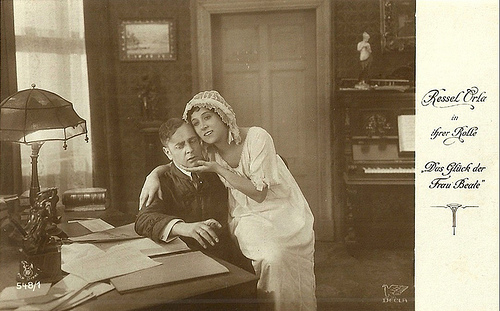
German postcard by Rotophot in the Film Sterne series, no. 548/1, 1919-1924. Photo: Decla. Publicity still for Das Glück der Frau Beate/The luck of the Mrs. Beate (Alwin Neuß, Otto Rippert, 1918).
The Sherlock Holmes of the silent era
What do we know about Das Glück der Frau Beate/The luck of the Mrs. Beate (1918)? The film is considered as lost and the plot is unclear. Das Glück der Frau Beate was produced by Decla Film (originally Deutsche Eclair), a German film production and distribution company of the silent era.
Decla was formed in 1911 as the German subsidiary of the French company Eclair, it was taken into German ownership in 1915 during the First World War. Under the leadership of Erich Pommer, Decla emerged as one of the leading German film companies of the early Weimar era.
The film was directed by a tandem, Alwin Neuß and Otto Rippert. Neuss was a well-known actor/director, noted for playing Sherlock Holmes in a series of silent films during the 1910s. Rippert was a noted film director during the silent era. In 1912 he started to work as a director for Continental-Kunstfilm of Berlin and made some ten films between 1912 and 1914. However, his reputation as one of the pioneers of German silent film rests on some of his later achievements,
Otto Rippert directed the classic silent film Homunculus (1916), produced by Deutsche Bioskop in 1916. Homunculus is a six-part serial science fiction film involving mad scientists, superhuman androids and sinister technology. The film foreshadows various elements of Metropolis (Fritz Lang, 1927), as well as serving as a model for later adaptations of Mary Shelley's 'Frankenstein'.
Das Glück der Frau Beate/The luck of the Mrs. Beate (1918) was the only film Otto Rippert and Alwin Neuss directed together. In 1924, Rippert stopped directing films and began to work as a film editor. The fame of Alwin Neuss began to fade in the 1920s, and he only appeared in few more films. Sound ended his film career.
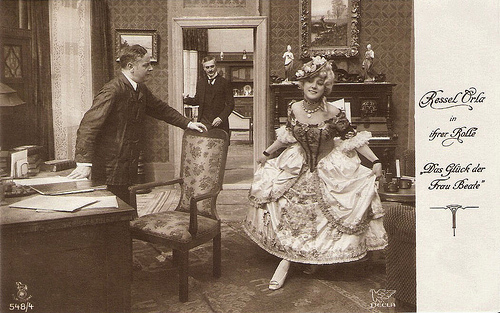
German postcard by Rotophot in the Film Sterne series, no. 548/4, 1919-1924. Photo: Decla. Publicity still for Das Glück der Frau Beate/The luck of the Mrs. Beate (Alwin Neuß, Otto Rippert, 1918).
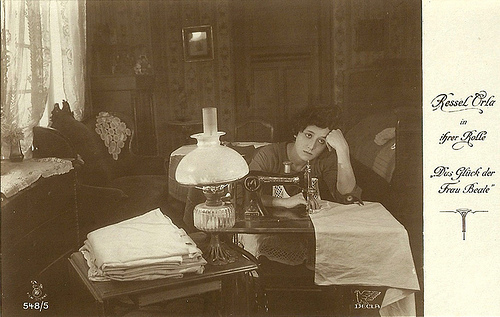
German postcard by Rotophot in the Film Sterne series, no. 548/5, 1919-1924. Photo: Decla. Publicity still for Das Glück der Frau Beate/The luck of the Mrs. Beate (Alwin Neuß, Otto Rippert, 1918).
Fritz Lang
The three main characters in Das Glück der Frau Beate/The luck of the Mrs. Beate (1918) were played by Emil Biron as the husband, Ressel Orla as Beate, and Max Ruhbeck as the admirer.
German actor Emil Biron made 29 films between 1917 and 1935, including Die Weber/The Weavers (Friedrich Zelnik, 1927) in which he played King Frederick William IV.
Ressel Orla was an Austrian-Jewish actress, who appeared in some of Fritz Lang's earliest films, including Halbblut/Half-blood (Fritz Lang, 1919), the first film Lang directed, and the serial adventure film Die Spinnen/The Spiders (Fritz Lang, 1919-1920), both starring Carl de Vogt .
Max Ruhbeck was a German actor, who appeared in more than ninety films from 1915 to 1923, including Otto Rippert's six chapter German science fiction film Homunculus, directed by Otto Rippert.
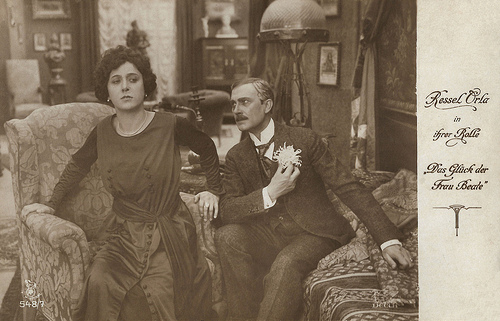
German postcard by Rotophot in the Film Sterne series, no. 548/7, 1919-1924. Photo: Decla. Publicity still for Das Glück der Frau Beate/The luck of the Mrs. Beate (Alwin Neuß, Otto Rippert, 1918).
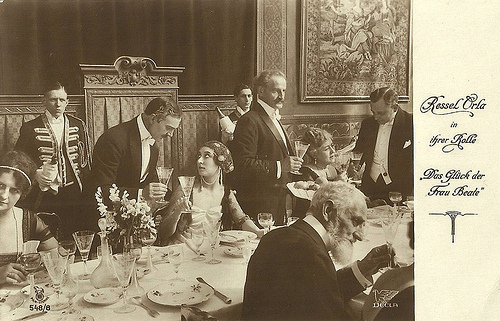
German postcard by Rotophot in the Film Sterne series, no. 548/8, 1919-1924. Photo: Decla. Publicity still for Das Glück der Frau Beate/The luck of the Mrs. Beate (Alwin Neuß, Otto Rippert, 1918).
Tomorrow EFSP has a post on another film by director Otto Rippert from the same year, the 'Sittenfilm' Der Weg, der zur Verdammnis führt, I. Das Schicksal der Änne Wolter/The Road to Damnation, 1. The Fate of Anne Wolter (Otto Rippert, 1918), with Charlotte Böcklin.
Sources: Wikipedia and IMDb.

German postcard by Rotophot in the Film Sterne series, no. 548/1, 1919-1924. Photo: Decla. Publicity still for Das Glück der Frau Beate/The luck of the Mrs. Beate (Alwin Neuß, Otto Rippert, 1918).
The Sherlock Holmes of the silent era
What do we know about Das Glück der Frau Beate/The luck of the Mrs. Beate (1918)? The film is considered as lost and the plot is unclear. Das Glück der Frau Beate was produced by Decla Film (originally Deutsche Eclair), a German film production and distribution company of the silent era.
Decla was formed in 1911 as the German subsidiary of the French company Eclair, it was taken into German ownership in 1915 during the First World War. Under the leadership of Erich Pommer, Decla emerged as one of the leading German film companies of the early Weimar era.
The film was directed by a tandem, Alwin Neuß and Otto Rippert. Neuss was a well-known actor/director, noted for playing Sherlock Holmes in a series of silent films during the 1910s. Rippert was a noted film director during the silent era. In 1912 he started to work as a director for Continental-Kunstfilm of Berlin and made some ten films between 1912 and 1914. However, his reputation as one of the pioneers of German silent film rests on some of his later achievements,
Otto Rippert directed the classic silent film Homunculus (1916), produced by Deutsche Bioskop in 1916. Homunculus is a six-part serial science fiction film involving mad scientists, superhuman androids and sinister technology. The film foreshadows various elements of Metropolis (Fritz Lang, 1927), as well as serving as a model for later adaptations of Mary Shelley's 'Frankenstein'.
Das Glück der Frau Beate/The luck of the Mrs. Beate (1918) was the only film Otto Rippert and Alwin Neuss directed together. In 1924, Rippert stopped directing films and began to work as a film editor. The fame of Alwin Neuss began to fade in the 1920s, and he only appeared in few more films. Sound ended his film career.

German postcard by Rotophot in the Film Sterne series, no. 548/4, 1919-1924. Photo: Decla. Publicity still for Das Glück der Frau Beate/The luck of the Mrs. Beate (Alwin Neuß, Otto Rippert, 1918).

German postcard by Rotophot in the Film Sterne series, no. 548/5, 1919-1924. Photo: Decla. Publicity still for Das Glück der Frau Beate/The luck of the Mrs. Beate (Alwin Neuß, Otto Rippert, 1918).
Fritz Lang
The three main characters in Das Glück der Frau Beate/The luck of the Mrs. Beate (1918) were played by Emil Biron as the husband, Ressel Orla as Beate, and Max Ruhbeck as the admirer.
German actor Emil Biron made 29 films between 1917 and 1935, including Die Weber/The Weavers (Friedrich Zelnik, 1927) in which he played King Frederick William IV.
Ressel Orla was an Austrian-Jewish actress, who appeared in some of Fritz Lang's earliest films, including Halbblut/Half-blood (Fritz Lang, 1919), the first film Lang directed, and the serial adventure film Die Spinnen/The Spiders (Fritz Lang, 1919-1920), both starring Carl de Vogt .
Max Ruhbeck was a German actor, who appeared in more than ninety films from 1915 to 1923, including Otto Rippert's six chapter German science fiction film Homunculus, directed by Otto Rippert.

German postcard by Rotophot in the Film Sterne series, no. 548/7, 1919-1924. Photo: Decla. Publicity still for Das Glück der Frau Beate/The luck of the Mrs. Beate (Alwin Neuß, Otto Rippert, 1918).

German postcard by Rotophot in the Film Sterne series, no. 548/8, 1919-1924. Photo: Decla. Publicity still for Das Glück der Frau Beate/The luck of the Mrs. Beate (Alwin Neuß, Otto Rippert, 1918).
Tomorrow EFSP has a post on another film by director Otto Rippert from the same year, the 'Sittenfilm' Der Weg, der zur Verdammnis führt, I. Das Schicksal der Änne Wolter/The Road to Damnation, 1. The Fate of Anne Wolter (Otto Rippert, 1918), with Charlotte Böcklin.
Sources: Wikipedia and IMDb.
Published on February 20, 2019 22:00
February 19, 2019
Titanic (1997)
Against expectations, the romantic epic and disaster film Titanic (1997), directed, written, co-produced and co-edited by James Cameron, became the highest-grossing film in the world and won 11 Oscars, including Best Picture and Best Director. The gigantic success transformed the young lead actors Kate Winslet and Leonardo DiCaprio into super stars. Young girls the world over idolised the two lovers bound for tragedy, and the film became a hype (remember Leo Mania?). From then on, everybody seemed either to love or hate the film. 20 years after the hype, Cameron's 3-hour epic is still a spectacularly emotional and visually stunning film.

French postcard by Salut. Photo: Paramount / Fox, 1998. Publicity still for Titanic (James Cameron, 1997) with Kate Winslet.
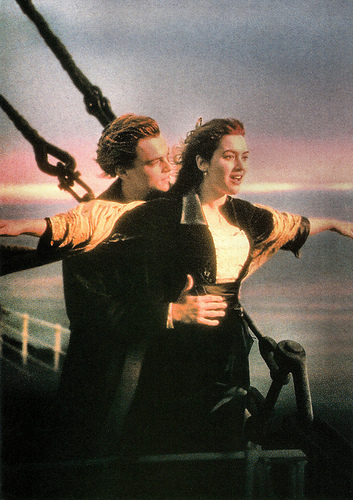
German postcard by Sunburst Merchandising GmbH, Osnabrück / Ana Anakos AG, München. Photo: Paramount / Fox, 1998. Publicity still for Titanic (James Cameron, 1997) with Kate Winslet and Leonardo DiCaprio.
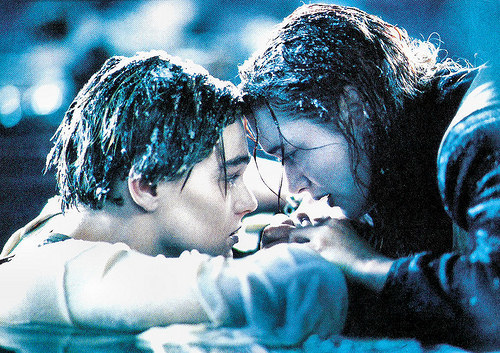
British postcard by Twentieth Century Fox / 7up, no. DD 2079A. Photo: Paramount / Fox. Publicity still for Titanic (James Cameron, 1997) with Kate Winslet and Leonardo DiCaprio.
The Heart of the Ocean
Titanic (James Cameron, 1997) tells the tale of the legendary ship Titanic on its first and last voyage, starting on 15 April 1912 at 2:20 in the morning. The film starts with a group searching the wreck of the RMS Titanic for treasures. They especially look for a necklace set with a valuable blue diamond called the Heart of the Ocean. Unsuccessful, they instead discover a drawing of a young woman wearing the Heart of the Ocean, dated the day the Titanic sank.
101-year-old Rose Dawson Calvert (Gloria Stuart) learns of the drawing on television, and contacts Lovett to inform him she is the woman in the drawing. She and her granddaughter Lizzy Calvert are flown to the boat where the search is being led to tell of what she remembers to help the search. When asked if she knew the whereabouts of the necklace, Rose Calvert recalls her memories aboard the Titanic, revealing for the first time that she was Rose DeWitt Bukater.
In 1912, the upper-class 17-year-old Rose ( Kate Winslet ) boards the Titanic in Southampton, Great Britain. She enters 'the most elegant ship in the world' together with her controlling fiance, Caledon Hockley (Billy Zane) and her desperate for money mother, Ruth DeWitt Bukater (Francis Fisher).
Distraught and frustrated by her engagement, Rose attempts suicide by jumping from the stern. Before she leaps, a drifter and artist named Jack Dawson (Leonardo DiCaprio) intervenes who convinces her not to jump. Dawson and his best friend Fabrizio De Rossi have won third-class tickets to the ship in a poker game.
Jack and Rose strike up a tentative friendship as she thanks him for saving her life, and he shares stories of his adventures travelling and sketching. Their bond deepens when they leave a first-class formal dinner of the wealthy for a much livelier gathering of dancing, music and beer in third-class. After revealing their love for each other and wish to leave together when the ship docks, they then witness the ship's fatal collision with an iceberg and now must escape together.
Captain Smith was urged by the White Star Line Director to increase the speed of the ship so they would make the newspaper headlines and receive extra publicity by arriving in New York on Thursday night and not on Friday morning as planned. The Titanic had reports that the waters in the Atlantic they were sailing in were full of icebergs, but the captain ignored these warnings and proceeded at full speed. On 15 April 1912 at 11:39, an iceberg was sighted. The ship crew attempted to shut off the engines and turn the ship out of the path of the iceberg but there was not enough time and the ship hit the iceberg on the starboard side as depicted in the film.
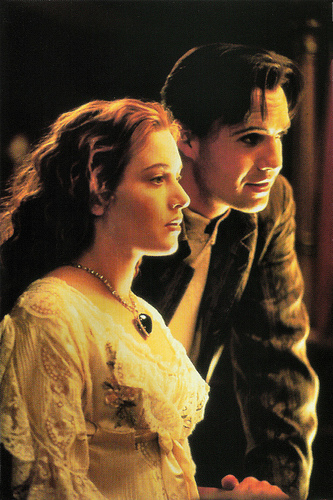
Australian postcard by FX Entertainment Products, Sydney Photo: Paramount / Fox, 1998. Publicity still for Titanic (James Cameron, 1997) with Kate Winslet and Billy Zane. Caption: "They call it 'Le Coeur de la Mer'."
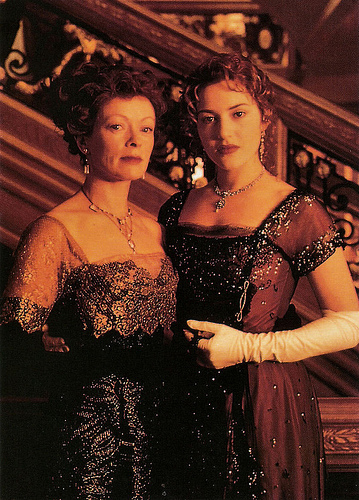
Thai postcard by Starpics / Suwan Studio. Photo: Paramount / Fox. Publicity still for Titanic (James Cameron, 1997) with Kate Winslet and Frances Fisher.
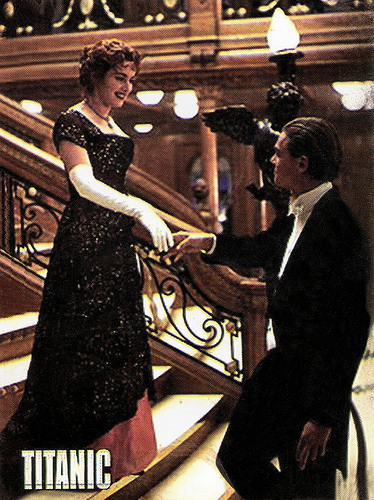
Vintage postcard. Photo: publicity still for Titanic (James Cameron, 1997) with Kate Winslet and Leonardo DiCaprio.
Why is Titanic a modern classic?
During the production of Titanic, perfectionist James Cameron went massively over time and budget, but this payed of well when it was clear he had managed what many had believed was impossible. Cameron had recreated a completely believable Titanic with accurate historical details. The sinking scenes are still amazing and horrific, as realistic as if you were there. Cameron respectfully shows what terror the victims went through that night. Titanic is both hunting and involving, filled with a wide range of deep feelings.
Cameron created the fictional love story to make sure that the public would remember those who lost their lives on the tragic voyage of the Titanic. The director weaved the historical details seamlessly around the fictional story of Jack and Rose. The audience sees the sinking of the Titanic primarily through their eyes. Cameron shows the various reactions to the crisis. Everyone reacts differently and Cameron gets his audience to contemplate of how they might have reacted in that situation, on the Titanic on that fateful night.
Kate Winslet and Leonardo DiCaprio are excellent. Both show great charisma and their chemistry as a romantic couple works. DeCaprio and Winslet flying at the ship's front rail remains a gorgeous magic moment. Winslet is the centre of the film and holds the story together beautifully. Frances Fisher is perfect as her mother, the snobby aristocrat, who forces her daughter to become engaged to marry a rich, arrogant racist. One can feel the fear and loathing she feels every time she looks at Jack.
Also very good is Kathy Bates as 'the unsinkable' Molly Brown, a historical 'nouveau riche' from Denver, who is a lot less uptight than the other folk in the upperclass department. Brown was saved and later had medals made up for the crew of the Carpethia that picked the survivors of Titanic up from the water. Her ticket on the Titanic had cost over four-thousand dollars, but by the end of her life she ended up broke.
Titanic won Academy Awards for Best Art Direction, Best Cinematography, Best Visual Effects, Best Film Editing, Best Costume Design, Best Sound, Best Sound Effects Editing, Best Original Dramatic Score, Best Original Song. Deservedly. The wonderful outfits and costuming were an excellent re-creation of the Post-Victorian era of 1912. All of the interiors of the ship were masterfully replicated down to the last pieces of china and silverware. The gymnasium, which is hardly seen in the film was recreated perfectly with all of the machines reproduced to match those seen in old photographs. James Horner's haunting score is also a key ingredient in the film's success. His music intensifies the emotions of the audience. Horner's love theme is still as beautiful as it is tragic.
Yes, Titanic (1997) is a modern classic, if you like it or not. Titanic became the first film to gross $1 billion, and stayed on the top of the box office charts for 12 years. Then it was kicked off the top by another James Cameron film, Avatar (2010). Over the years, it became somewhat fashionable to slag Titanic off, but just see it for yourself.
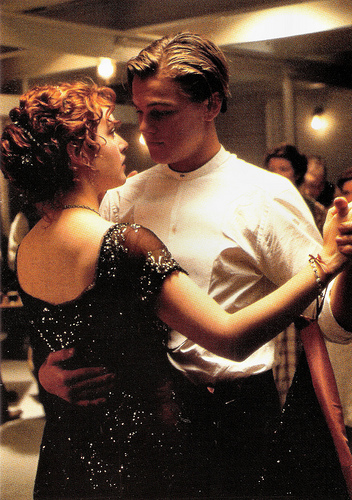
German postcard by Sunburst Merchandising GmbH, Osnabrück / Ana Anakos AG, München. Photo: Paramount / Fox, 1998. Publicity still for Titanic (James Cameron, 1997) with Kate Winslet and Leonardo DiCaprio.
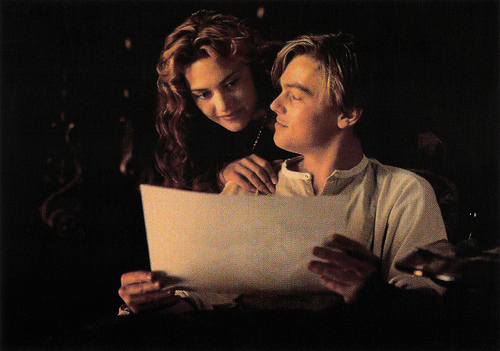
German postcard by Sunburst Merchandising GmbH, Osnabrück / Ana Anakos AG, München. Photo: Paramount / Fox, 1998. Publicity still for Titanic (James Cameron, 1997).
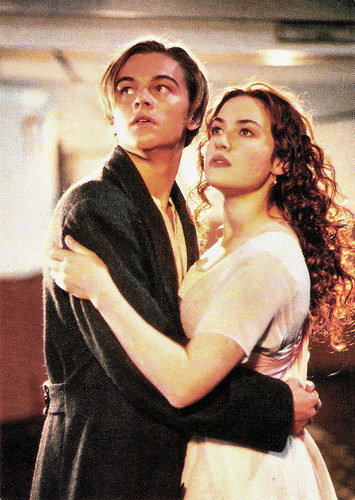
German postcard by Sunburst Merchandising GmbH, Osnabrück / Ana Anakos AG, München. Photo: Paramount / Fox, 1998. Publicity still for Titanic (James Cameron, 1997).
Sources: Wikipedia and IMDb.

French postcard by Salut. Photo: Paramount / Fox, 1998. Publicity still for Titanic (James Cameron, 1997) with Kate Winslet.

German postcard by Sunburst Merchandising GmbH, Osnabrück / Ana Anakos AG, München. Photo: Paramount / Fox, 1998. Publicity still for Titanic (James Cameron, 1997) with Kate Winslet and Leonardo DiCaprio.

British postcard by Twentieth Century Fox / 7up, no. DD 2079A. Photo: Paramount / Fox. Publicity still for Titanic (James Cameron, 1997) with Kate Winslet and Leonardo DiCaprio.
The Heart of the Ocean
Titanic (James Cameron, 1997) tells the tale of the legendary ship Titanic on its first and last voyage, starting on 15 April 1912 at 2:20 in the morning. The film starts with a group searching the wreck of the RMS Titanic for treasures. They especially look for a necklace set with a valuable blue diamond called the Heart of the Ocean. Unsuccessful, they instead discover a drawing of a young woman wearing the Heart of the Ocean, dated the day the Titanic sank.
101-year-old Rose Dawson Calvert (Gloria Stuart) learns of the drawing on television, and contacts Lovett to inform him she is the woman in the drawing. She and her granddaughter Lizzy Calvert are flown to the boat where the search is being led to tell of what she remembers to help the search. When asked if she knew the whereabouts of the necklace, Rose Calvert recalls her memories aboard the Titanic, revealing for the first time that she was Rose DeWitt Bukater.
In 1912, the upper-class 17-year-old Rose ( Kate Winslet ) boards the Titanic in Southampton, Great Britain. She enters 'the most elegant ship in the world' together with her controlling fiance, Caledon Hockley (Billy Zane) and her desperate for money mother, Ruth DeWitt Bukater (Francis Fisher).
Distraught and frustrated by her engagement, Rose attempts suicide by jumping from the stern. Before she leaps, a drifter and artist named Jack Dawson (Leonardo DiCaprio) intervenes who convinces her not to jump. Dawson and his best friend Fabrizio De Rossi have won third-class tickets to the ship in a poker game.
Jack and Rose strike up a tentative friendship as she thanks him for saving her life, and he shares stories of his adventures travelling and sketching. Their bond deepens when they leave a first-class formal dinner of the wealthy for a much livelier gathering of dancing, music and beer in third-class. After revealing their love for each other and wish to leave together when the ship docks, they then witness the ship's fatal collision with an iceberg and now must escape together.
Captain Smith was urged by the White Star Line Director to increase the speed of the ship so they would make the newspaper headlines and receive extra publicity by arriving in New York on Thursday night and not on Friday morning as planned. The Titanic had reports that the waters in the Atlantic they were sailing in were full of icebergs, but the captain ignored these warnings and proceeded at full speed. On 15 April 1912 at 11:39, an iceberg was sighted. The ship crew attempted to shut off the engines and turn the ship out of the path of the iceberg but there was not enough time and the ship hit the iceberg on the starboard side as depicted in the film.

Australian postcard by FX Entertainment Products, Sydney Photo: Paramount / Fox, 1998. Publicity still for Titanic (James Cameron, 1997) with Kate Winslet and Billy Zane. Caption: "They call it 'Le Coeur de la Mer'."

Thai postcard by Starpics / Suwan Studio. Photo: Paramount / Fox. Publicity still for Titanic (James Cameron, 1997) with Kate Winslet and Frances Fisher.

Vintage postcard. Photo: publicity still for Titanic (James Cameron, 1997) with Kate Winslet and Leonardo DiCaprio.
Why is Titanic a modern classic?
During the production of Titanic, perfectionist James Cameron went massively over time and budget, but this payed of well when it was clear he had managed what many had believed was impossible. Cameron had recreated a completely believable Titanic with accurate historical details. The sinking scenes are still amazing and horrific, as realistic as if you were there. Cameron respectfully shows what terror the victims went through that night. Titanic is both hunting and involving, filled with a wide range of deep feelings.
Cameron created the fictional love story to make sure that the public would remember those who lost their lives on the tragic voyage of the Titanic. The director weaved the historical details seamlessly around the fictional story of Jack and Rose. The audience sees the sinking of the Titanic primarily through their eyes. Cameron shows the various reactions to the crisis. Everyone reacts differently and Cameron gets his audience to contemplate of how they might have reacted in that situation, on the Titanic on that fateful night.
Kate Winslet and Leonardo DiCaprio are excellent. Both show great charisma and their chemistry as a romantic couple works. DeCaprio and Winslet flying at the ship's front rail remains a gorgeous magic moment. Winslet is the centre of the film and holds the story together beautifully. Frances Fisher is perfect as her mother, the snobby aristocrat, who forces her daughter to become engaged to marry a rich, arrogant racist. One can feel the fear and loathing she feels every time she looks at Jack.
Also very good is Kathy Bates as 'the unsinkable' Molly Brown, a historical 'nouveau riche' from Denver, who is a lot less uptight than the other folk in the upperclass department. Brown was saved and later had medals made up for the crew of the Carpethia that picked the survivors of Titanic up from the water. Her ticket on the Titanic had cost over four-thousand dollars, but by the end of her life she ended up broke.
Titanic won Academy Awards for Best Art Direction, Best Cinematography, Best Visual Effects, Best Film Editing, Best Costume Design, Best Sound, Best Sound Effects Editing, Best Original Dramatic Score, Best Original Song. Deservedly. The wonderful outfits and costuming were an excellent re-creation of the Post-Victorian era of 1912. All of the interiors of the ship were masterfully replicated down to the last pieces of china and silverware. The gymnasium, which is hardly seen in the film was recreated perfectly with all of the machines reproduced to match those seen in old photographs. James Horner's haunting score is also a key ingredient in the film's success. His music intensifies the emotions of the audience. Horner's love theme is still as beautiful as it is tragic.
Yes, Titanic (1997) is a modern classic, if you like it or not. Titanic became the first film to gross $1 billion, and stayed on the top of the box office charts for 12 years. Then it was kicked off the top by another James Cameron film, Avatar (2010). Over the years, it became somewhat fashionable to slag Titanic off, but just see it for yourself.

German postcard by Sunburst Merchandising GmbH, Osnabrück / Ana Anakos AG, München. Photo: Paramount / Fox, 1998. Publicity still for Titanic (James Cameron, 1997) with Kate Winslet and Leonardo DiCaprio.

German postcard by Sunburst Merchandising GmbH, Osnabrück / Ana Anakos AG, München. Photo: Paramount / Fox, 1998. Publicity still for Titanic (James Cameron, 1997).

German postcard by Sunburst Merchandising GmbH, Osnabrück / Ana Anakos AG, München. Photo: Paramount / Fox, 1998. Publicity still for Titanic (James Cameron, 1997).
Sources: Wikipedia and IMDb.
Published on February 19, 2019 22:00
February 18, 2019
Grand Hotel (1932)
Grand Hotel (1932) was an all-star drama, directed by Edmund Goulding and produced by Irving Thalberg for M.G.M. William A. Drake wrote the screenplay based on his own play Grand Hotel (1930) which in turn was based on the German novel Menschen im Hotel (1929) by Vicki Baum. The film won an Oscar for Best Picture and was a box office hit. The phrase "Grand Hotel theme" has come to be used for any film drama following the activities of various people in a large busy place, with some characters' lives overlapping in odd ways and some of them remaining unaware of one another's existence.
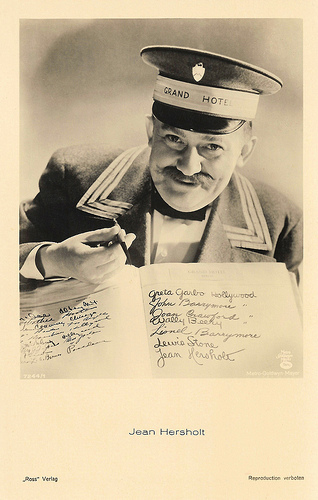
German postcard by Ross Verlag, no. 7244/1, 1932-1933, distributed in Italy by Casa Editrice Ballerini & Fratini, Firenze. Photo: Metro-Goldwyn-Mayer. Publicity still for Grand Hotel (Edmund Goulding, 1932) with Jean Hersholt .
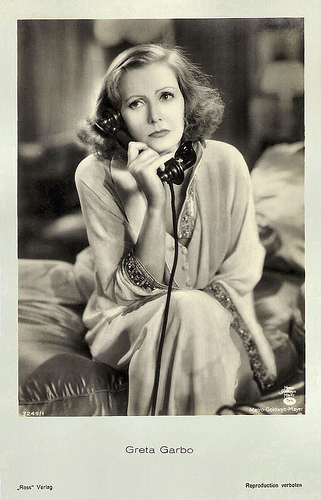
German postcard by Ross Verlag, no. 7249/1, 1932-1933. Photo: Metro-Goldwyn-Mayer. Publicity still for Grand Hotel (Edmund Goulding, 1932) with Greta Garbo .
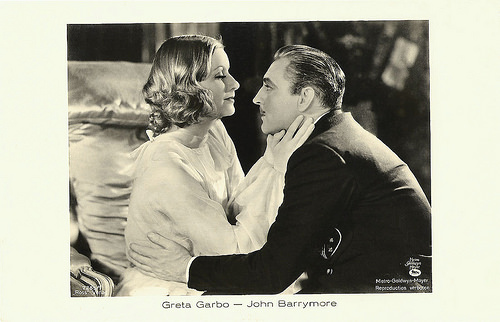
German postcard by Ross Verlag, no. 7285/1, 1932-1933. Photo: Metro-Goldwyn-Mayer. Publicity still for Grand Hotel (Edmund Goulding, 1932) with Greta Garbo and John Barrymore.
People come, people go. Nothing ever happens
The setting for Grand Hotel (Edmund Goulding, 1932) is Berlin's plushest, most expensive hotel. Lewis Stone plays Doctor Otternschlag, a disfigured veteran of World War I, usually drunk and a permanent resident of the Grand Hotel. He observes: "People coming, going. Nothing ever happens". His statement proves to be false, as the film follows several guests over the course of one tumultuous day.
John Barrymore is Baron Felix von Geigern, who squandered his fortune and supports himself as a card player and occasional jewel thief. He befriends Otto Kringelein (Lionel Barrymore), a lowly bookkeeper who is dying and has decided to spend his remaining days in the lap of luxury. Kringelein's former employer, industrialist General Director Preysing (Wallace Beery), is at the hotel to close an important deal, and he hires stenographer Flaemmchen (Joan Crawford) to assist him. She aspires to be an actress and shows Preysing some magazine photos for which she posed, implying she is willing to offer him more than typing if he advances her career.
Another guest is the eccentric Russian prima ballerina Grusinskaya ( Greta Garbo ), whose career is on the wane. When the Baron is in her room to steal her pearls and she returns from the theatre, he hides in her room and overhears as she talks to herself about wanting to end it all. He comes out of hiding and engages her in conversation, and Grusinskaya finds herself attracted to him. The following morning, the Baron returns Grusinskaya's jewels, and she forgives his crime. She invites him to accompany her to Vienna, an offer he accepts.
The Baron is desperate for money to pay his way out of the criminal group he had been working with. He and Kringelein get a card game going, and Kringelein wins everything, then becomes intoxicated. When he drops his wallet, the Baron stashes it in his pocket, intending to keep the winnings. However, after Kringelein begins to search for his lost belongings, the Baron – who desperately needs the money but has become very fond of Kringelein – pretends to have discovered the wallet and returns it to him.
As part of a desperate merger plan, Preysing must travel to London, and he asks Flaemmchen to accompany him. Later, when the two are in her room, which opens on to his, Preysing sees the shadow of the Baron rifling through his belongings. He confronts the Baron; the two struggle, and Preysing bludgeons the Baron with the telephone, killing him. Flaemmchen sees what happened and tells Kringelein, who confronts Preysing. He insists he acted in self-defense, but Kringelein summons the police and Preysing is arrested.
Grusinskaya departs for the train station, expecting to find the Baron waiting for her there. Meanwhile, Kringelein offers to take care of Flaemmchen, who suggests they seek a cure for his illness. As they leave the hotel, Doctor Otternschlag again observes, "Grand Hotel. Always the same. People come. People go. Nothing ever happens."
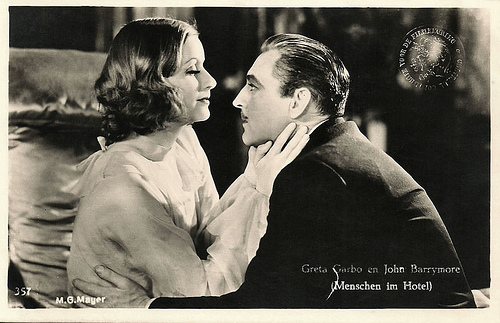
Dutch postcard, no. 357. Photo: Metro-Goldwyn-Mayer. Publicity still for Grand Hotel (Edmund Goulding, 1932) with Greta Garbo and John Barrymore. The subtitle mentions the German release title Menschen im Hotel, also the title of the book by Vicky Baum on which the film was based. The mark on the card is that of the Dutch Board of Film Censors.
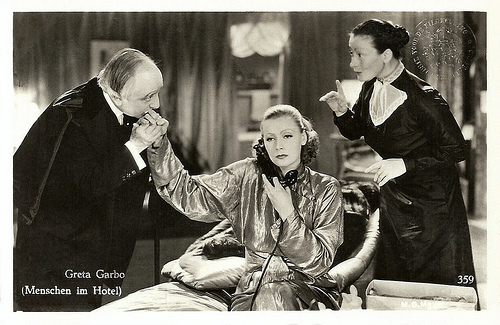
Dutch postcard, no. 359. Photo: Metro-Goldwyn-Mayer. Publicity still for Grand Hotel (Edmund Goulding, 1932) with Ferdinand Gottschalk (Pimenov), Greta Garbo (Grusinskaya) and Rafaela Ottiano (Suzette).
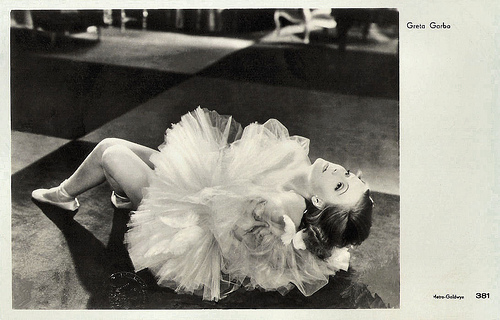
Dutch postcard by JosPe, no. 381. Photo: Metro-Goldwyn-Mayer. Publicity still for Grand Hotel (Edmund Goulding, 1932) with Greta Garbo .
I want to be alone
Producer Irving Thalberg purchased the rights to Vicki Baum's novel Menschen im Hotel for $13,000 and then commissioned William Absalom Drake to adapt it for the stage. It opened on Broadway at the National Theatre on 13 November 1930 and ran for 459 performances. Pleased with its success, Thalberg had Drake and Béla Balázs write the screenplay and budgeted the project at $700,000.
Thalberg made it into MGM's first 'all star' film with an A-list of star performers: the divine Garbo, not one but two Barrymores, Wallace Beery, Joan Crawford, Lewis Stone, and with Jean Hersholt , Rafaela Ottiano and Ferdinand Gottschalk in sterling supporting roles. There was concern that putting so much talent into one film, instead of spreading the stars out over 4 or 5 films, would lose the studio money. But Grand Hotel (Edmund Goulding, 1932) was a great success, critically and financially.
Grand Hotel (1932) was seen as an artistic achievement in its art direction and production quality. The art director, Cedric Gibbons, was one of the most important and influential in the history of American film. The lobby scenes were extremely well done, portraying a 360° desk. This allowed audiences to watch the hotel action from all around the characters. It changed the way sets were made from that point onward.
Mordaunt Hall of The New York Times praised in 1932 the performances of Greta Garbo and John Barrymore, in a mostly positive review. "So far as the direction is concerned, Edmund Goulding has done an excellent piece of work, but occasionally it seems as though he relies too much on close-ups. Nevertheless he has sustained a steady momentum in darting here and there in the busy hostelry and working up to an effective dramatic pitch at the psychological moment. (...) Miss Garbo, possibly appreciating that she was supported by a galaxy of efficient performers, decided that she would do her utmost to make her role shine. And she succeeds admirably. She is stunning in her early scenes and charming in the love scene with Baron Geigern, portrayed by John Barrymore with his usual savoir faire."
More than 80 years later, Ron Oliver reviews at IMDb : "Watch how the plot weaves the threads of the characters' lives into a finished tapestry. One of the great movies. Tremendously satisfying." And Richard Gilliam at AllMovie adds: "Grand Hotel is the prototype for the all-star ensemble film and an excellent example of the rich and glamorous escapist entertainment, often from MGM, that took on enhanced prominence during the Depression. Produced by Irving Thalberg using top-end ingredients and state-of-the-art technology, it is yet another example of MGM's dominance during the 1930s for this type of film."
At the time of the shooting, there was some controversy about Greta Garbo , with her strong Swedish accent, impersonating the Russian dancer Grusinskaya, played on the stage by Eugenie Leontovich. She delivers the line "I want to be alone" and, immediately following, "I just want to be alone." Soon after, in conversation with Baron Felix von Gaigern (John Barrymore), she says "And I want to be alone." Referring to its legendary use as a characterisation of her personal reclusive life, Garbo later insisted, "I never said I want to be alone; I only said 'I want to be let alone.' There is all the difference.
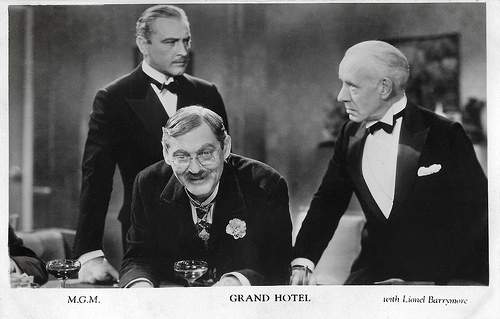
British postcard by Film Weekly. Photo: M.G.M. Publicity still for Grand Hotel (Edmund Goulding, 1932) with Lionel Barrymore, Lewis Stone, and John Barrymore.
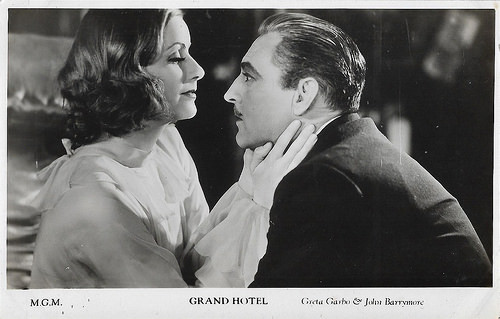
British postcard by Film Weekly. Photo: M.G.M. Publicity still for Grand Hotel (Edmund Goulding, 1932) with Greta Garbo and John Barrymore.
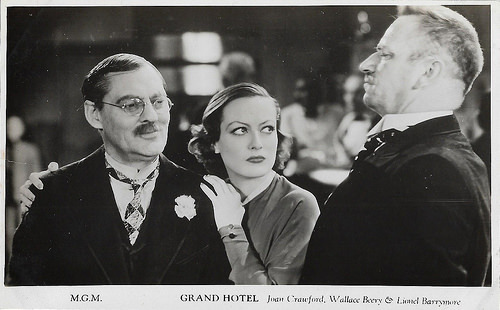
British postcard by Film Weekly. Photo: M.G.M. Publicity still for Grand Hotel (Edmund Goulding, 1932) with Joan Crawford, Wallace Beery, and Lionel Barrymore.
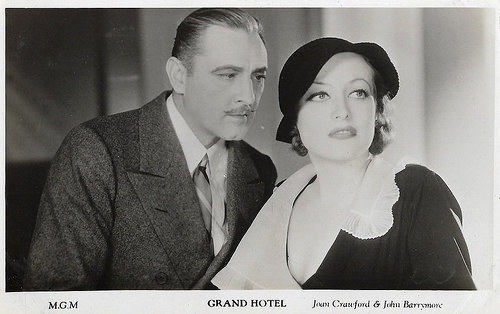
British postcard by Film Weekly. Photo: M.G.M. Publicity still for Grand Hotel (Edmund Goulding, 1932) with Joan Crawford and John Barrymore.
Sources: Mordaunt Hall (New York Times), Ron Oliver (IMDb), Richard Gilliam (AllMovie), Wikipedia and IMDb.

German postcard by Ross Verlag, no. 7244/1, 1932-1933, distributed in Italy by Casa Editrice Ballerini & Fratini, Firenze. Photo: Metro-Goldwyn-Mayer. Publicity still for Grand Hotel (Edmund Goulding, 1932) with Jean Hersholt .

German postcard by Ross Verlag, no. 7249/1, 1932-1933. Photo: Metro-Goldwyn-Mayer. Publicity still for Grand Hotel (Edmund Goulding, 1932) with Greta Garbo .

German postcard by Ross Verlag, no. 7285/1, 1932-1933. Photo: Metro-Goldwyn-Mayer. Publicity still for Grand Hotel (Edmund Goulding, 1932) with Greta Garbo and John Barrymore.
People come, people go. Nothing ever happens
The setting for Grand Hotel (Edmund Goulding, 1932) is Berlin's plushest, most expensive hotel. Lewis Stone plays Doctor Otternschlag, a disfigured veteran of World War I, usually drunk and a permanent resident of the Grand Hotel. He observes: "People coming, going. Nothing ever happens". His statement proves to be false, as the film follows several guests over the course of one tumultuous day.
John Barrymore is Baron Felix von Geigern, who squandered his fortune and supports himself as a card player and occasional jewel thief. He befriends Otto Kringelein (Lionel Barrymore), a lowly bookkeeper who is dying and has decided to spend his remaining days in the lap of luxury. Kringelein's former employer, industrialist General Director Preysing (Wallace Beery), is at the hotel to close an important deal, and he hires stenographer Flaemmchen (Joan Crawford) to assist him. She aspires to be an actress and shows Preysing some magazine photos for which she posed, implying she is willing to offer him more than typing if he advances her career.
Another guest is the eccentric Russian prima ballerina Grusinskaya ( Greta Garbo ), whose career is on the wane. When the Baron is in her room to steal her pearls and she returns from the theatre, he hides in her room and overhears as she talks to herself about wanting to end it all. He comes out of hiding and engages her in conversation, and Grusinskaya finds herself attracted to him. The following morning, the Baron returns Grusinskaya's jewels, and she forgives his crime. She invites him to accompany her to Vienna, an offer he accepts.
The Baron is desperate for money to pay his way out of the criminal group he had been working with. He and Kringelein get a card game going, and Kringelein wins everything, then becomes intoxicated. When he drops his wallet, the Baron stashes it in his pocket, intending to keep the winnings. However, after Kringelein begins to search for his lost belongings, the Baron – who desperately needs the money but has become very fond of Kringelein – pretends to have discovered the wallet and returns it to him.
As part of a desperate merger plan, Preysing must travel to London, and he asks Flaemmchen to accompany him. Later, when the two are in her room, which opens on to his, Preysing sees the shadow of the Baron rifling through his belongings. He confronts the Baron; the two struggle, and Preysing bludgeons the Baron with the telephone, killing him. Flaemmchen sees what happened and tells Kringelein, who confronts Preysing. He insists he acted in self-defense, but Kringelein summons the police and Preysing is arrested.
Grusinskaya departs for the train station, expecting to find the Baron waiting for her there. Meanwhile, Kringelein offers to take care of Flaemmchen, who suggests they seek a cure for his illness. As they leave the hotel, Doctor Otternschlag again observes, "Grand Hotel. Always the same. People come. People go. Nothing ever happens."

Dutch postcard, no. 357. Photo: Metro-Goldwyn-Mayer. Publicity still for Grand Hotel (Edmund Goulding, 1932) with Greta Garbo and John Barrymore. The subtitle mentions the German release title Menschen im Hotel, also the title of the book by Vicky Baum on which the film was based. The mark on the card is that of the Dutch Board of Film Censors.

Dutch postcard, no. 359. Photo: Metro-Goldwyn-Mayer. Publicity still for Grand Hotel (Edmund Goulding, 1932) with Ferdinand Gottschalk (Pimenov), Greta Garbo (Grusinskaya) and Rafaela Ottiano (Suzette).

Dutch postcard by JosPe, no. 381. Photo: Metro-Goldwyn-Mayer. Publicity still for Grand Hotel (Edmund Goulding, 1932) with Greta Garbo .
I want to be alone
Producer Irving Thalberg purchased the rights to Vicki Baum's novel Menschen im Hotel for $13,000 and then commissioned William Absalom Drake to adapt it for the stage. It opened on Broadway at the National Theatre on 13 November 1930 and ran for 459 performances. Pleased with its success, Thalberg had Drake and Béla Balázs write the screenplay and budgeted the project at $700,000.
Thalberg made it into MGM's first 'all star' film with an A-list of star performers: the divine Garbo, not one but two Barrymores, Wallace Beery, Joan Crawford, Lewis Stone, and with Jean Hersholt , Rafaela Ottiano and Ferdinand Gottschalk in sterling supporting roles. There was concern that putting so much talent into one film, instead of spreading the stars out over 4 or 5 films, would lose the studio money. But Grand Hotel (Edmund Goulding, 1932) was a great success, critically and financially.
Grand Hotel (1932) was seen as an artistic achievement in its art direction and production quality. The art director, Cedric Gibbons, was one of the most important and influential in the history of American film. The lobby scenes were extremely well done, portraying a 360° desk. This allowed audiences to watch the hotel action from all around the characters. It changed the way sets were made from that point onward.
Mordaunt Hall of The New York Times praised in 1932 the performances of Greta Garbo and John Barrymore, in a mostly positive review. "So far as the direction is concerned, Edmund Goulding has done an excellent piece of work, but occasionally it seems as though he relies too much on close-ups. Nevertheless he has sustained a steady momentum in darting here and there in the busy hostelry and working up to an effective dramatic pitch at the psychological moment. (...) Miss Garbo, possibly appreciating that she was supported by a galaxy of efficient performers, decided that she would do her utmost to make her role shine. And she succeeds admirably. She is stunning in her early scenes and charming in the love scene with Baron Geigern, portrayed by John Barrymore with his usual savoir faire."
More than 80 years later, Ron Oliver reviews at IMDb : "Watch how the plot weaves the threads of the characters' lives into a finished tapestry. One of the great movies. Tremendously satisfying." And Richard Gilliam at AllMovie adds: "Grand Hotel is the prototype for the all-star ensemble film and an excellent example of the rich and glamorous escapist entertainment, often from MGM, that took on enhanced prominence during the Depression. Produced by Irving Thalberg using top-end ingredients and state-of-the-art technology, it is yet another example of MGM's dominance during the 1930s for this type of film."
At the time of the shooting, there was some controversy about Greta Garbo , with her strong Swedish accent, impersonating the Russian dancer Grusinskaya, played on the stage by Eugenie Leontovich. She delivers the line "I want to be alone" and, immediately following, "I just want to be alone." Soon after, in conversation with Baron Felix von Gaigern (John Barrymore), she says "And I want to be alone." Referring to its legendary use as a characterisation of her personal reclusive life, Garbo later insisted, "I never said I want to be alone; I only said 'I want to be let alone.' There is all the difference.

British postcard by Film Weekly. Photo: M.G.M. Publicity still for Grand Hotel (Edmund Goulding, 1932) with Lionel Barrymore, Lewis Stone, and John Barrymore.

British postcard by Film Weekly. Photo: M.G.M. Publicity still for Grand Hotel (Edmund Goulding, 1932) with Greta Garbo and John Barrymore.

British postcard by Film Weekly. Photo: M.G.M. Publicity still for Grand Hotel (Edmund Goulding, 1932) with Joan Crawford, Wallace Beery, and Lionel Barrymore.

British postcard by Film Weekly. Photo: M.G.M. Publicity still for Grand Hotel (Edmund Goulding, 1932) with Joan Crawford and John Barrymore.
Sources: Mordaunt Hall (New York Times), Ron Oliver (IMDb), Richard Gilliam (AllMovie), Wikipedia and IMDb.
Published on February 18, 2019 22:00
February 17, 2019
John Gilbert
American actor, screenwriter and director John Gilbert (1899-1936) rose to fame during the silent film era and became a popular leading man known as 'The Great Lover'.
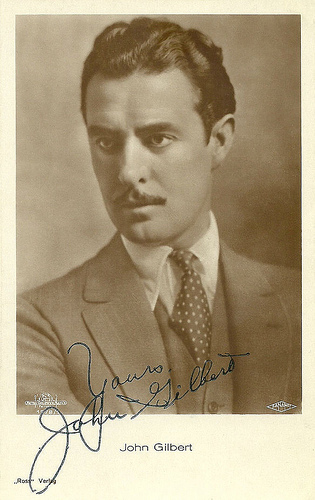
German postcard by Ross Verlag, no. 1578/1, 1927-1928. Photo: Metro Goldwyn Mayer / FaNaMet. Collection: Didier Hanson.
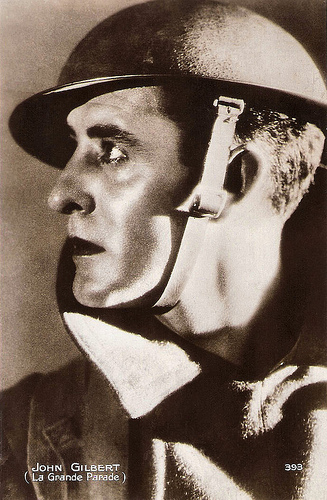
French postcard by Editions Cinémagazine, Paris, no. 393. Photo: MGM. Publicity still for The Big Parade (King Vidor, 1925).
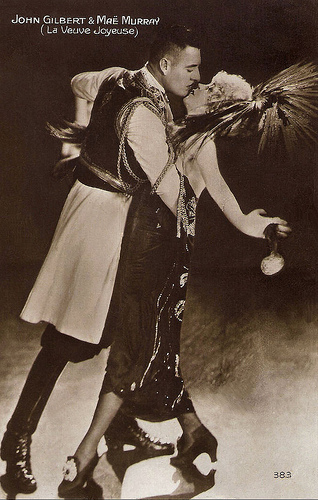
French postcard by Cinémagazine-Edition, Paris, no. 383. Photo: Metro-Goldwyn-Film. Publicity still for The Merry Widow (Erich von Stroheim, 1925) with Mae Murray.

German postcard by Ross Verlag, no. 63/1. Photo: Metro-Goldwyn-Mayer (MGM) / Parufamet. Publicity still for La Bohème (King Vidor, 1926) with Lillian Gish .
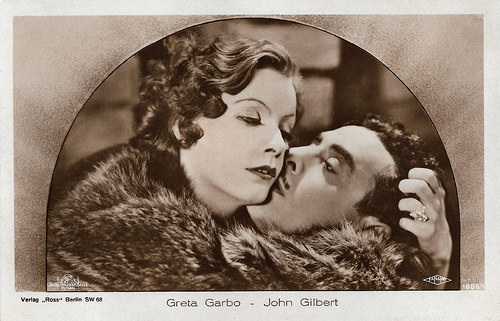
German postcard by Ross Verlag, no. 1886/1, 1927-1928. Photo: Clarence Sinclair Bull / Metro-Goldwyn-Mayer. Publicity still for Flesh and the Devil (Clarence Brown, 1926) with Greta Garbo .
Turning from villain to leading man
John Gilbert was born John Cecil Pringle in Logan, Utah, in 1899. His parents, John Pringle (1865–1929) and Ida Apperly Gilbert (1877–1913), were both stock-company actors. His father was a comic with the Pringle Stock Company. John struggled through a childhood of abuse and neglect. His family moved frequently and Gilbert attended several schools throughout the United States. After his family settled in California, he attended Hitchcock Military Academy in San Rafael, California.
After he left school Gilbert worked as a rubber goods salesman in San Francisco, then as a stage manager in stock company in Spokane, Washington in 1915. He lost his job when the company folded. He decided to try acting and got work in films as an extra. Gilbert first appeared in a short directed by Wilfred Lucas, The Mother Instinct (1915). He found work as an extra with the Thomas Ince Studios on films such as the historical war drama The Coward (Reginald Barker, 1915), the drama Aloha Oe (Richard Stanton, Charles Swickard, Gilbert P. Hamilton, 1915), and William S. Hart's Western Hell's Hinges (Charles Swickard, William S. Hart, Clifford Smith, 1916).
Gilbert began to get parts at Kay-Bee Pictures, billed as 'Jack Gilbert' in the Western The Aryan (William S. Hart, Reginald Barker, Clifford Smith, 1916) with William S. Hart, and the war film Shell 43 (Reginald Barker, 1916) with H.B. Warner. He had an early leading part in Kay-Bee's The Apostle of Vengeance (William S. Hart, Clifford Smith, 1916).
His first leading role was in Princess of the Dark (Charles Miller, 1917) with Enid Bennett, but the film was not a big success and he went back to supporting roles in The Dark Road (Charles Miller, 1917), Happiness (Reginald Barker, 1917), and the drama The Hater of Men (Charles Miller, 1917). Gilbert did The White Heather (Maurice Tourneur, 1919) for Maurice Tourneur, Widow by Proxy (Walter Edwards, 1919) for Paramount, and Heart o' the Hills (Joseph De Grasse, Sidney Franklin, 1919) for Mary Pickford.
Tourneur signed him to a contract to both write and act in films. Gilbert acted in and co-wrote The White Circle (Maurice Tourneur, 1920), The Great Redeemer (Clarence Brown, Maurice Tourneur, 1921) and Deep Waters (Maurice Tourneur, 1921). As a writer only he worked on The Bait (Maurice Tourneur, 1921), starring and produced by Hope Hampton. For Hampton, Gilbert wrote and directed, but did not appear in Love's Penalty (1921).
In 1921 he signed a three-year contract with Fox Films. His popularity continued to soar and he was turning from villain to leading man. Fox gave Gilbert his first real starring part in Shame (Emmett J. Flynn, 1921). He followed it with leading roles in such films as Arabian Love (Jerome Storm, 1922) with Barbara LaMarr, Monte Cristo (Emmett J. Flynn, 1922) an adaptation of Alexandre Dumas' 'The Count of Monte Cristo', and A California Romance (1922). Many of these films were written by Jules Furthman.
He returned to Tourneur to costar with Lon Chaney in While Paris Sleeps (Maurice Tourneur, 1923). Back at Fox, Gilbert starred in Truxton King (Jerome Storm, 1923), St. Elmo (Jerome Storm, 1923) with Barbara LaMarr and Bessie Love, and the drama Cameo Kirby (1923), directed by John Ford, and co-starring Jean Arthur in her film debut. He appeared in The Wolf Man (Edmund Mortimer, 1923) with Norma Shearer. It was not a horror film, but the story of a man who believes he murdered his fiancee's brother while drunk.
In 1924 he signed with MGM which put him into His Hour (King Vidor, 1924), written by Elinor Glyn and co-starring Aileen Pringle. It was a big success. He followed this with such high profile films as He Who Gets Slapped (Victor Sjöström, 1924) co-starring Lon Chaney and Norma Shearer; and The Merry Widow (Erich von Stroheim, 1925), co-starring Mae Murray. The latter was a huge box office success.
Gilbert was once again directed by Vidor in the war epic The Big Parade (King Vidor, 1925), which became the second-highest grossing silent film and the most profitable film of the silent era. His performance in this film made him a major star. Now at the height of his career, Gilbert rivalled Rudolph Valentino , another silent film era leading man, as a box office draw. Lillian Gish , who had a new contract with MGM, picked Gilbert to co-star with her in La Bohème (King Vidor, 1926). He then did another with Vidor, Bardelys the Magnificent (King Vidor, 1926).
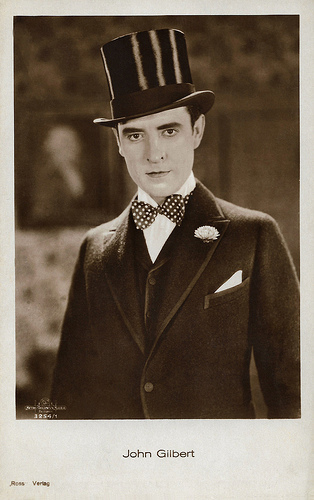
German postcard by Ross Verlag, no. 3254/1, 1928-1929. Photo: Metro-Goldwyn-Mayer.
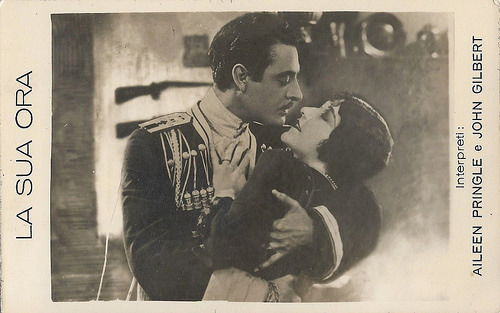
Italian postcard. Photo: MGM. John Gilbert and Aileen Pringle in the American silent drama His Hour (King Vidor, 1924).
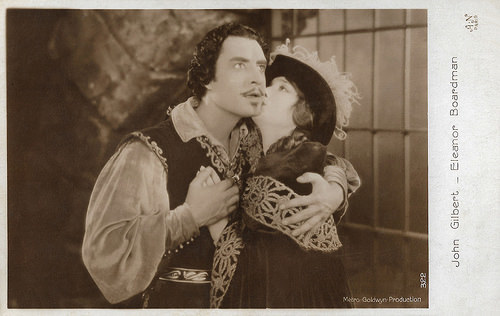
French postcard by A.N., Paris, no. 322. Photo: Metro-Goldwyn-Production. Publicity still for Bardelys the Magnificent (King Vidor, 1926) with Eleonor Boardman.
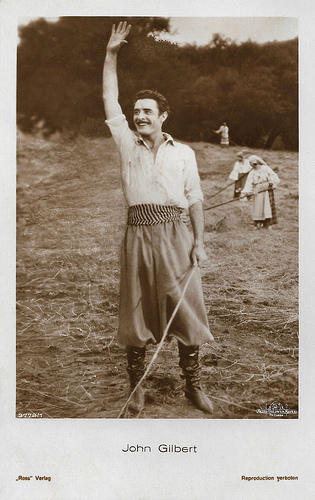
German postcard by Ross Verlag, no. 3778/1. Photo: Metro-Goldwyn-Mayer. Publicity still for The Cossacks (George Hill, Clarence Brown, 1928).
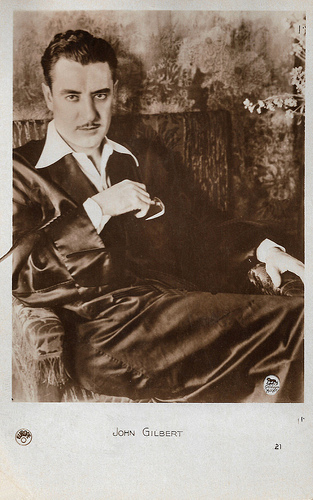
French postcard by Europe, no. 21. Photo: Metro-Goldwyn-Mayer.
A torrid off-screen affair
Then came Greta Garbo . In 1926, Gilbert made Flesh and the Devil (Clarence Brown, 1926), his first film with Garbo. They soon began a highly publicised, torrid off-screen affair, much to the delight of their fans. The screen chemistry between the two was incredible, and the studio publicity department worked overtime to publicise the romance between the two. The couple starred together again in Love (Edmund Goulding, 1927), and A Woman of Affairs (Clarence Brown, 1928).
When it came time to marry, John was reportedly left at the altar. His performances after that were devoid of the sparkle that he once had and he began to drink heavily. Gilbert's popularity began to wane when silent pictures gave way to talkies. Though Gilbert was often cited as one of the high-profile examples of an actor who was unsuccessful in making the transition to talkies, his decline as a star had far more to do with studio politics and money than with the sound of his screen voice, which was rich and distinctive. Throughout his time at MGM, Gilbert frequently clashed with studio head Louis B. Mayer over creative, social and financial matters.
Audiences awaited Gilbert's first romantic role on the talking screen. The vehicle was the Ruritanian romance His Glorious Night (1929), directed by Lionel Barrymore. According to reviewers, audiences laughed nervously at Gilbert's performance. The fault was not Gilbert's voice, it was said, but the awkward scenario along with overly ardent love scenes. In one, Gilbert keeps kissing his leading lady, (Catherine Dale Owen), while saying "I love you" over and over again. The scene was parodied in the MGM musical Singin' in the Rain (Stanley Donen, Gene Kelly, 1952) in which a preview of the fictional The Dueling Cavalier flops disastrously.
Garbo tried to restore some of his image when she insisted that he played opposite her in Queen Christina (Rouben Mamoulian, 1933), but by then it was too late. Columbia Pictures gave him what would be his final chance for a comeback in The Captain Hates the Sea (Lewis Milestone, 1934). The film involves a Grand Hotel-style series of intertwining stories involving the passengers on a cruise ship and Gilbert gave a capable performance as a frustrated playwright. But the off-screen cast of heavy drinkers encouraged his alcoholism and the film was his last. By 1934, alcoholism had severely damaged Gilbert's health. He suffered a serious heart attack in December 1935, which left him in poor health. Gilbert suffered a second heart attack at his Bel Air home on 9 January 1936, which was fatal.
Gilbert was married four times. His first marriage was to Olivia Burwell (1918-1921). In February 1921, Gilbert announced his engagement to actress Leatrice Joy. They married in Tijuana in November 1921. As Gilbert had failed to secure a divorce from his first wife and the legality of Gilbert and Joy's Mexican marriage was questionable, the couple separated and had the marriage annulled to avoid a scandal. They remarried in March 1922. The marriage was tumultuous and, in June 1923, Joy filed for legal separation after she claimed that Gilbert slapped her face after a night of heavy drinking. They reconciled several months later. In August 1924, Joy, who was pregnant with the couple's first child, filed for divorce. Joy later said she left Gilbert after discovering he was having an affair with actress Laurette Taylor. Joy also claimed that Gilbert had conducted affairs with Barbara La Marr, Lila Lee and Bebe Daniels . Gilbert and Joy had a daughter, Leatrice Gilbert (1924-2015). Joy was granted a divorce in May 1925.
In 1929, Gilbert eloped with actress Ina Claire to Las Vegas. They separated in February 1931 and divorced six months later. Gilbert's fourth and final marriage was in August 1932, to actress Virginia Bruce, who had recently costarred with him on the MGM film Downstairs (Monta Bell, 1932). Bruce retired briefly from acting following the birth of their daughter Susan Ann; however, she resumed her career after their divorce in May 1934.
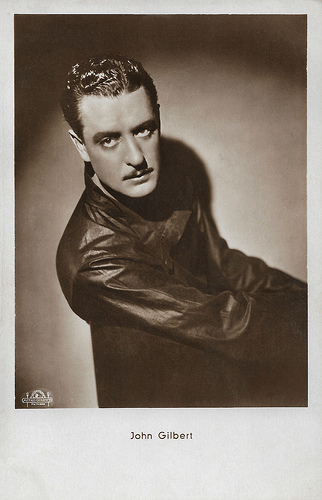
Austrian postcard by Iris Verlag, no. 6017. Photo: Metro-Goldwyn Pictures.
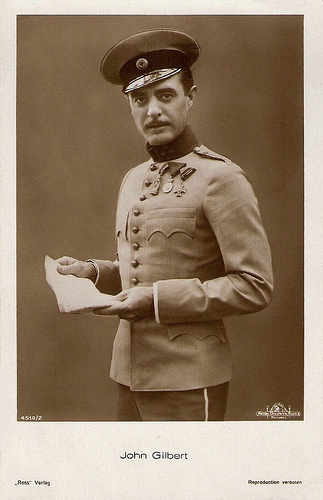
German postcard by Ross Verlag, no. 4510/2, 1929-1930. Photo: Metro-Goldwyn-Mayer. Publicity still for His Glorious Night (Lionel Barrymore, 1929).
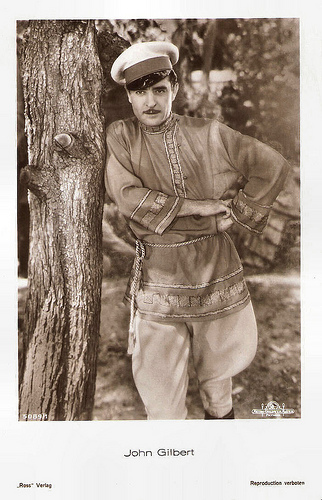
German postcard by Ross Verlag, no. 5089/1, 1930-1931. Photo: Metro-Goldwyn-Mayer. Publicity still for Redemption (Fred Niblo, 1930).
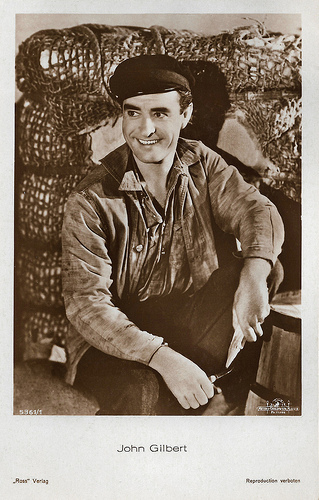
German postcard by Ross Verlag, no. 5361/1, 1930-1931. Photo: Metro-Goldwyn-Mayer. John Gilbert in the American pre-Code sound film Way for a Sailor (Sam Wood, 1930).
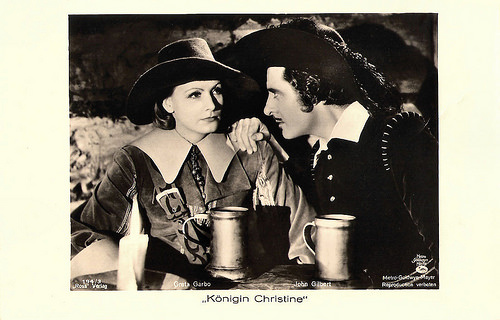
German postcard by Ross Verlag, no. 194/3. Photo: MGM. Publicity still for Queen Christina (Rouben Mamoulian, 1933) with Greta Garbo .
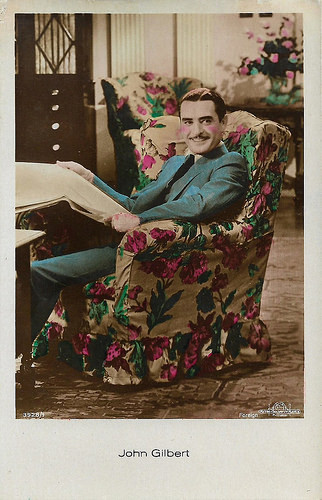
German postcard by Ross Verlag Foreign, no. 3938/1, 1928-1929. Photo: Metro-Goldwyn-Mayer.
Sources: (IMDb), Wikipedia and .

German postcard by Ross Verlag, no. 1578/1, 1927-1928. Photo: Metro Goldwyn Mayer / FaNaMet. Collection: Didier Hanson.

French postcard by Editions Cinémagazine, Paris, no. 393. Photo: MGM. Publicity still for The Big Parade (King Vidor, 1925).

French postcard by Cinémagazine-Edition, Paris, no. 383. Photo: Metro-Goldwyn-Film. Publicity still for The Merry Widow (Erich von Stroheim, 1925) with Mae Murray.

German postcard by Ross Verlag, no. 63/1. Photo: Metro-Goldwyn-Mayer (MGM) / Parufamet. Publicity still for La Bohème (King Vidor, 1926) with Lillian Gish .

German postcard by Ross Verlag, no. 1886/1, 1927-1928. Photo: Clarence Sinclair Bull / Metro-Goldwyn-Mayer. Publicity still for Flesh and the Devil (Clarence Brown, 1926) with Greta Garbo .
Turning from villain to leading man
John Gilbert was born John Cecil Pringle in Logan, Utah, in 1899. His parents, John Pringle (1865–1929) and Ida Apperly Gilbert (1877–1913), were both stock-company actors. His father was a comic with the Pringle Stock Company. John struggled through a childhood of abuse and neglect. His family moved frequently and Gilbert attended several schools throughout the United States. After his family settled in California, he attended Hitchcock Military Academy in San Rafael, California.
After he left school Gilbert worked as a rubber goods salesman in San Francisco, then as a stage manager in stock company in Spokane, Washington in 1915. He lost his job when the company folded. He decided to try acting and got work in films as an extra. Gilbert first appeared in a short directed by Wilfred Lucas, The Mother Instinct (1915). He found work as an extra with the Thomas Ince Studios on films such as the historical war drama The Coward (Reginald Barker, 1915), the drama Aloha Oe (Richard Stanton, Charles Swickard, Gilbert P. Hamilton, 1915), and William S. Hart's Western Hell's Hinges (Charles Swickard, William S. Hart, Clifford Smith, 1916).
Gilbert began to get parts at Kay-Bee Pictures, billed as 'Jack Gilbert' in the Western The Aryan (William S. Hart, Reginald Barker, Clifford Smith, 1916) with William S. Hart, and the war film Shell 43 (Reginald Barker, 1916) with H.B. Warner. He had an early leading part in Kay-Bee's The Apostle of Vengeance (William S. Hart, Clifford Smith, 1916).
His first leading role was in Princess of the Dark (Charles Miller, 1917) with Enid Bennett, but the film was not a big success and he went back to supporting roles in The Dark Road (Charles Miller, 1917), Happiness (Reginald Barker, 1917), and the drama The Hater of Men (Charles Miller, 1917). Gilbert did The White Heather (Maurice Tourneur, 1919) for Maurice Tourneur, Widow by Proxy (Walter Edwards, 1919) for Paramount, and Heart o' the Hills (Joseph De Grasse, Sidney Franklin, 1919) for Mary Pickford.
Tourneur signed him to a contract to both write and act in films. Gilbert acted in and co-wrote The White Circle (Maurice Tourneur, 1920), The Great Redeemer (Clarence Brown, Maurice Tourneur, 1921) and Deep Waters (Maurice Tourneur, 1921). As a writer only he worked on The Bait (Maurice Tourneur, 1921), starring and produced by Hope Hampton. For Hampton, Gilbert wrote and directed, but did not appear in Love's Penalty (1921).
In 1921 he signed a three-year contract with Fox Films. His popularity continued to soar and he was turning from villain to leading man. Fox gave Gilbert his first real starring part in Shame (Emmett J. Flynn, 1921). He followed it with leading roles in such films as Arabian Love (Jerome Storm, 1922) with Barbara LaMarr, Monte Cristo (Emmett J. Flynn, 1922) an adaptation of Alexandre Dumas' 'The Count of Monte Cristo', and A California Romance (1922). Many of these films were written by Jules Furthman.
He returned to Tourneur to costar with Lon Chaney in While Paris Sleeps (Maurice Tourneur, 1923). Back at Fox, Gilbert starred in Truxton King (Jerome Storm, 1923), St. Elmo (Jerome Storm, 1923) with Barbara LaMarr and Bessie Love, and the drama Cameo Kirby (1923), directed by John Ford, and co-starring Jean Arthur in her film debut. He appeared in The Wolf Man (Edmund Mortimer, 1923) with Norma Shearer. It was not a horror film, but the story of a man who believes he murdered his fiancee's brother while drunk.
In 1924 he signed with MGM which put him into His Hour (King Vidor, 1924), written by Elinor Glyn and co-starring Aileen Pringle. It was a big success. He followed this with such high profile films as He Who Gets Slapped (Victor Sjöström, 1924) co-starring Lon Chaney and Norma Shearer; and The Merry Widow (Erich von Stroheim, 1925), co-starring Mae Murray. The latter was a huge box office success.
Gilbert was once again directed by Vidor in the war epic The Big Parade (King Vidor, 1925), which became the second-highest grossing silent film and the most profitable film of the silent era. His performance in this film made him a major star. Now at the height of his career, Gilbert rivalled Rudolph Valentino , another silent film era leading man, as a box office draw. Lillian Gish , who had a new contract with MGM, picked Gilbert to co-star with her in La Bohème (King Vidor, 1926). He then did another with Vidor, Bardelys the Magnificent (King Vidor, 1926).

German postcard by Ross Verlag, no. 3254/1, 1928-1929. Photo: Metro-Goldwyn-Mayer.

Italian postcard. Photo: MGM. John Gilbert and Aileen Pringle in the American silent drama His Hour (King Vidor, 1924).

French postcard by A.N., Paris, no. 322. Photo: Metro-Goldwyn-Production. Publicity still for Bardelys the Magnificent (King Vidor, 1926) with Eleonor Boardman.

German postcard by Ross Verlag, no. 3778/1. Photo: Metro-Goldwyn-Mayer. Publicity still for The Cossacks (George Hill, Clarence Brown, 1928).

French postcard by Europe, no. 21. Photo: Metro-Goldwyn-Mayer.
A torrid off-screen affair
Then came Greta Garbo . In 1926, Gilbert made Flesh and the Devil (Clarence Brown, 1926), his first film with Garbo. They soon began a highly publicised, torrid off-screen affair, much to the delight of their fans. The screen chemistry between the two was incredible, and the studio publicity department worked overtime to publicise the romance between the two. The couple starred together again in Love (Edmund Goulding, 1927), and A Woman of Affairs (Clarence Brown, 1928).
When it came time to marry, John was reportedly left at the altar. His performances after that were devoid of the sparkle that he once had and he began to drink heavily. Gilbert's popularity began to wane when silent pictures gave way to talkies. Though Gilbert was often cited as one of the high-profile examples of an actor who was unsuccessful in making the transition to talkies, his decline as a star had far more to do with studio politics and money than with the sound of his screen voice, which was rich and distinctive. Throughout his time at MGM, Gilbert frequently clashed with studio head Louis B. Mayer over creative, social and financial matters.
Audiences awaited Gilbert's first romantic role on the talking screen. The vehicle was the Ruritanian romance His Glorious Night (1929), directed by Lionel Barrymore. According to reviewers, audiences laughed nervously at Gilbert's performance. The fault was not Gilbert's voice, it was said, but the awkward scenario along with overly ardent love scenes. In one, Gilbert keeps kissing his leading lady, (Catherine Dale Owen), while saying "I love you" over and over again. The scene was parodied in the MGM musical Singin' in the Rain (Stanley Donen, Gene Kelly, 1952) in which a preview of the fictional The Dueling Cavalier flops disastrously.
Garbo tried to restore some of his image when she insisted that he played opposite her in Queen Christina (Rouben Mamoulian, 1933), but by then it was too late. Columbia Pictures gave him what would be his final chance for a comeback in The Captain Hates the Sea (Lewis Milestone, 1934). The film involves a Grand Hotel-style series of intertwining stories involving the passengers on a cruise ship and Gilbert gave a capable performance as a frustrated playwright. But the off-screen cast of heavy drinkers encouraged his alcoholism and the film was his last. By 1934, alcoholism had severely damaged Gilbert's health. He suffered a serious heart attack in December 1935, which left him in poor health. Gilbert suffered a second heart attack at his Bel Air home on 9 January 1936, which was fatal.
Gilbert was married four times. His first marriage was to Olivia Burwell (1918-1921). In February 1921, Gilbert announced his engagement to actress Leatrice Joy. They married in Tijuana in November 1921. As Gilbert had failed to secure a divorce from his first wife and the legality of Gilbert and Joy's Mexican marriage was questionable, the couple separated and had the marriage annulled to avoid a scandal. They remarried in March 1922. The marriage was tumultuous and, in June 1923, Joy filed for legal separation after she claimed that Gilbert slapped her face after a night of heavy drinking. They reconciled several months later. In August 1924, Joy, who was pregnant with the couple's first child, filed for divorce. Joy later said she left Gilbert after discovering he was having an affair with actress Laurette Taylor. Joy also claimed that Gilbert had conducted affairs with Barbara La Marr, Lila Lee and Bebe Daniels . Gilbert and Joy had a daughter, Leatrice Gilbert (1924-2015). Joy was granted a divorce in May 1925.
In 1929, Gilbert eloped with actress Ina Claire to Las Vegas. They separated in February 1931 and divorced six months later. Gilbert's fourth and final marriage was in August 1932, to actress Virginia Bruce, who had recently costarred with him on the MGM film Downstairs (Monta Bell, 1932). Bruce retired briefly from acting following the birth of their daughter Susan Ann; however, she resumed her career after their divorce in May 1934.

Austrian postcard by Iris Verlag, no. 6017. Photo: Metro-Goldwyn Pictures.

German postcard by Ross Verlag, no. 4510/2, 1929-1930. Photo: Metro-Goldwyn-Mayer. Publicity still for His Glorious Night (Lionel Barrymore, 1929).

German postcard by Ross Verlag, no. 5089/1, 1930-1931. Photo: Metro-Goldwyn-Mayer. Publicity still for Redemption (Fred Niblo, 1930).

German postcard by Ross Verlag, no. 5361/1, 1930-1931. Photo: Metro-Goldwyn-Mayer. John Gilbert in the American pre-Code sound film Way for a Sailor (Sam Wood, 1930).

German postcard by Ross Verlag, no. 194/3. Photo: MGM. Publicity still for Queen Christina (Rouben Mamoulian, 1933) with Greta Garbo .

German postcard by Ross Verlag Foreign, no. 3938/1, 1928-1929. Photo: Metro-Goldwyn-Mayer.
Sources: (IMDb), Wikipedia and .
Published on February 17, 2019 22:00
February 16, 2019
Bruno Ganz (1941-2019)
Yesterday, 15 January 2019, Swiss actor Bruno Ganz passed away. Ganz established himself in Germany, first as co-founder of the Schaubuhne Theatre company, then as a romantic lead in films. International renown came Ganz' way when he starred in Eric Rohmer's The Marquise of O (1976). Subsequent film roles ranged from Jonathan Harker in Werner Herzog's Nosferatu/Nosferatu: Phantom of the Night (1979) with Klaus Kinski and Isabelle Adjani, to misplaced angel Damiel in Wim Wenders' Der Himmel über Berlin/Wings of Desire (1987). He also starred in international features by Franklin J. Schaffner, Jonathan Demme and Francis Ford Coppola, and he played Adolf Hitler in the Academy Award-nominated film Der Untergang/Downfall (2004). Bruno Ganz was 77.
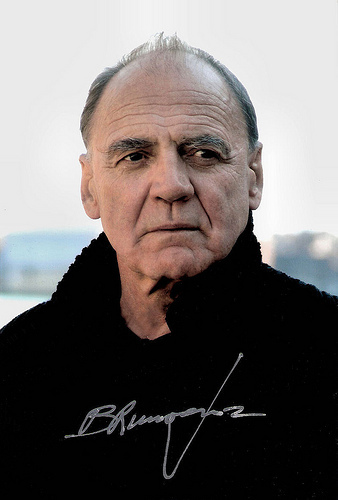
German autograph card.
A spirited argument with Dennis Hopper about acting technique
Bruno Ganz was born in 1941 in Zürich-Seebach, Switzerland. His parents were a Swiss mechanic father and a northern Italian mother.
Bruno had decided to pursue an acting career by the time he entered university. His film debut was Der Herr mit der schwarzen Melone/The Gentleman in the Black Derby (Karl Suter, 1960), which was not a success.
He debuted at the theatre in 1961 and gained a reputation as a reflexive, charismatic and technically brilliant stage actor. In 1970 he founded with Peter Stein the theatre company 'Schaubühne' in Berlin.
In cinema, Ganz slowly became one of the best-known and most acclaimed actors in the German language. He collaborated with many of the most respected European directors of his time, most notably Eric Rohmer, Werner Herzog and especially Wim Wenders.
Probably his most memorable collaboration with Wenders was Der Amerikanische Freund/The American Friend (Wim Wenders, 1977), an adaptation of Patricia Highsmith's novel 'Ripley's Game'. Ganz regarded it as one of his favourite films, even though he and co-star Dennis Hopper came to blows during a spirited argument about acting technique.
His performance as the angel Damiel in Der Himmel über Berlin/Wings of Desire (Wim Wenders, 1987) became so iconic, that he could make a short and silent appearance as the same character in Börn náttúrunnar (Friðrik Þór Friðriksson, 1991) without confusing the audience. Later, he would reprise the role in the sequel In weiter Ferne, so nah!/Faraway, So Close (Wim Wenders, 1993).
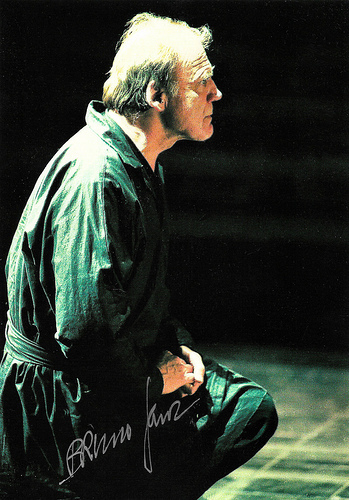
German autograph card. Photo: Ruth Walz.
The German-speaking actor judged 'most significant and worthy'
Bruno Ganz acted in three features nominated for the 'Best Foreign Language Film' Academy Award: Börn náttúrunnar/Children of Nature (Friðrik Þór Friðriksson, 1991), Der Untergang/Downfall (Oliver Hirschbiegel, 2004) and Der Baader Meinhof Komplex/The Baader Meinhof Complex (Uli Edel, 2008) with Martina Gedeck and Moritz Bleibtreu. He also appeared in a feature nominated for 'Best Picture': The Reader (Stephen Daldry, 2008) with Kate Winslet and Ralph Fiennes.
Der Untergang/Downfall (Oliver Hirschbiegel, 2004) told the story of Hitler's final days in his Berlin bunker. It grossed $92m at box offices around the world when it was released.
On stage, Ganz portrayed Dr. Heinrich Faust in Peter Stein's the 11-hour staging of 'Faust, Part One' and 'Faust, Part Two' in 2000. His great performance was also filmed for TV in Johann Wolfgang von Goethe: Faust I (Peter Schönhofer, 2001) and Johann Wolfgang von Goethe: Faust II (Thomas Grimm, 2001).
Among his more recent films were Unknown (Jaume Collet-Serra, 2011) with Liam Neeson, The Counselor (Ridley Scott, 2013) with Michael Fassbinder, and he played a pseudo-scientific healer in Sally Potter's The Party (2017).
One of his last roles was in Lars von Trier's psychological horror art film The House that Jack Built (2018) on a serial killer, played by Matt Dillon.
At the time of his death, Bruno Ganz was the holder of the Republic of Austria's Iffland-Ring, a 200 years old accolade to the German-speaking actor judged 'most significant and worthy'. In 1996, Ganz inherited it from his colleague Josef Meinrad. The ring is passed from person to person, and it is not yet clear who Ganz had intended it to transfer to on the occasion of his death.
On 15 February 2019, Bruno Ganz died of colon cancer in his hometown Zürich, Switzerland. He was married to Sabine Ganz and the couple had one son, Daniel (1972). They lived separate, and Ganz's longtime companion was the photographer Ruth Walz.
Trailer Der Amerikanische Freund/The American Friend (1977). Source: Dionysus Cinema (YouTube).
Trailer Der Untergang/Downfall (2004). Source: pagontradLT (YouTube).
Trailer The House that Jack Built (2018). Source: IFC Films (YouTube).
Sources: Hal Erickson (AllMovie), (IMDb), BBC News, Wikipedia and .

German autograph card.
A spirited argument with Dennis Hopper about acting technique
Bruno Ganz was born in 1941 in Zürich-Seebach, Switzerland. His parents were a Swiss mechanic father and a northern Italian mother.
Bruno had decided to pursue an acting career by the time he entered university. His film debut was Der Herr mit der schwarzen Melone/The Gentleman in the Black Derby (Karl Suter, 1960), which was not a success.
He debuted at the theatre in 1961 and gained a reputation as a reflexive, charismatic and technically brilliant stage actor. In 1970 he founded with Peter Stein the theatre company 'Schaubühne' in Berlin.
In cinema, Ganz slowly became one of the best-known and most acclaimed actors in the German language. He collaborated with many of the most respected European directors of his time, most notably Eric Rohmer, Werner Herzog and especially Wim Wenders.
Probably his most memorable collaboration with Wenders was Der Amerikanische Freund/The American Friend (Wim Wenders, 1977), an adaptation of Patricia Highsmith's novel 'Ripley's Game'. Ganz regarded it as one of his favourite films, even though he and co-star Dennis Hopper came to blows during a spirited argument about acting technique.
His performance as the angel Damiel in Der Himmel über Berlin/Wings of Desire (Wim Wenders, 1987) became so iconic, that he could make a short and silent appearance as the same character in Börn náttúrunnar (Friðrik Þór Friðriksson, 1991) without confusing the audience. Later, he would reprise the role in the sequel In weiter Ferne, so nah!/Faraway, So Close (Wim Wenders, 1993).

German autograph card. Photo: Ruth Walz.
The German-speaking actor judged 'most significant and worthy'
Bruno Ganz acted in three features nominated for the 'Best Foreign Language Film' Academy Award: Börn náttúrunnar/Children of Nature (Friðrik Þór Friðriksson, 1991), Der Untergang/Downfall (Oliver Hirschbiegel, 2004) and Der Baader Meinhof Komplex/The Baader Meinhof Complex (Uli Edel, 2008) with Martina Gedeck and Moritz Bleibtreu. He also appeared in a feature nominated for 'Best Picture': The Reader (Stephen Daldry, 2008) with Kate Winslet and Ralph Fiennes.
Der Untergang/Downfall (Oliver Hirschbiegel, 2004) told the story of Hitler's final days in his Berlin bunker. It grossed $92m at box offices around the world when it was released.
On stage, Ganz portrayed Dr. Heinrich Faust in Peter Stein's the 11-hour staging of 'Faust, Part One' and 'Faust, Part Two' in 2000. His great performance was also filmed for TV in Johann Wolfgang von Goethe: Faust I (Peter Schönhofer, 2001) and Johann Wolfgang von Goethe: Faust II (Thomas Grimm, 2001).
Among his more recent films were Unknown (Jaume Collet-Serra, 2011) with Liam Neeson, The Counselor (Ridley Scott, 2013) with Michael Fassbinder, and he played a pseudo-scientific healer in Sally Potter's The Party (2017).
One of his last roles was in Lars von Trier's psychological horror art film The House that Jack Built (2018) on a serial killer, played by Matt Dillon.
At the time of his death, Bruno Ganz was the holder of the Republic of Austria's Iffland-Ring, a 200 years old accolade to the German-speaking actor judged 'most significant and worthy'. In 1996, Ganz inherited it from his colleague Josef Meinrad. The ring is passed from person to person, and it is not yet clear who Ganz had intended it to transfer to on the occasion of his death.
On 15 February 2019, Bruno Ganz died of colon cancer in his hometown Zürich, Switzerland. He was married to Sabine Ganz and the couple had one son, Daniel (1972). They lived separate, and Ganz's longtime companion was the photographer Ruth Walz.
Trailer Der Amerikanische Freund/The American Friend (1977). Source: Dionysus Cinema (YouTube).
Trailer Der Untergang/Downfall (2004). Source: pagontradLT (YouTube).
Trailer The House that Jack Built (2018). Source: IFC Films (YouTube).
Sources: Hal Erickson (AllMovie), (IMDb), BBC News, Wikipedia and .
Published on February 16, 2019 22:00
February 15, 2019
Photo by Svenska Biografteatern
AB Svenska Biografteatern, also called Svenska Bio, was a film company operating between 1907 and 1919. During the 1910s, Svenska Bio became internationally recognised with films directed by the former stage directors Victor Sjöström and Mauritz Stiller. In 1913, Sjöström directed Ingeborg Holm (1913), which is now considered the first classic of Swedish cinema. A year later, Svenska Bio introduced feature films in the Swedish cinema. In 1919 Svenska Bio merged with Filmindustri AB Skandia and continued its operations as Svensk Filmindustri AB.
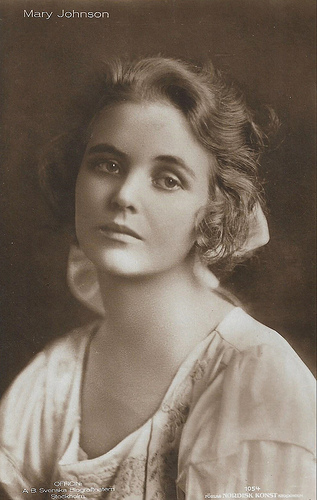
Mary Johnson. Swedish postcard by Förlag Nordisk Konst, Stockholm, no. 1054. Photo: A.B. Svenska Biografteatern, Stockholm.
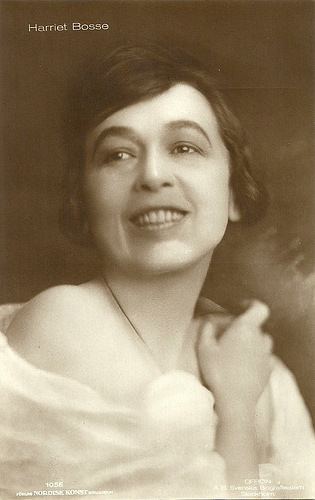
Harriet Bosse . Swedish postcard by Förlag Nordisk Konst, Stockholm, no. 1056. Photo: A.B. Svenska Biografteatern, Stockholm.
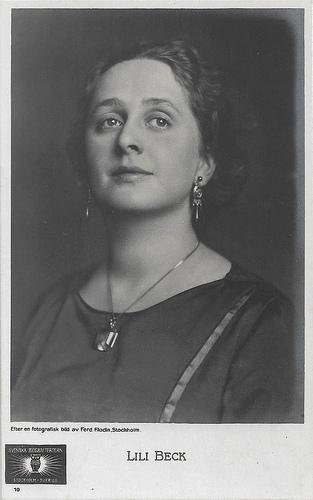
Lili Beck . Swedish postcard by Svenska Biografteatern, Stockholm, no. 10. Photo: Ferd. Flodin, Stockholm.
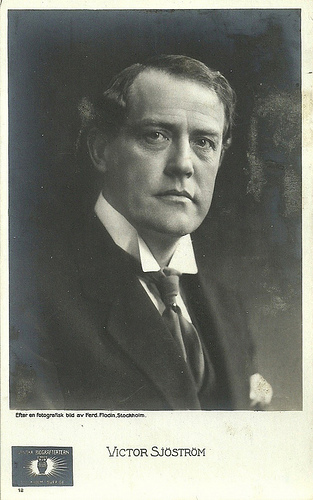
Victor Sjöström . Swedish postcard by Svenska Biografteatern, Stockholm, no. 12. Photo: Ferd. Flodin, Stockholm.

Richard Lund. Swedish postcard by Svenska Biografteatern, Stockholm, no. 13. Photo: Ferd. Flodin, Stockholm.
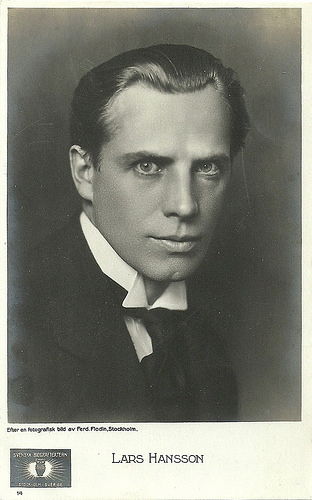
Swedish postcard by Svenska Biografteatern, Stockholm, no. 14. Photo: Ferd. Flodin, Stockholm. Lars Hanson 's last name is spelled Hansson on this card.
The first Swedish film studio
Sweden has only a small population, but no other country matched the fame of the Swedish cinema during the 1910s and 1920s. The main Swedish studio at the time was AB Svenska Biografteatern, or Svenska Bio.
AB Svenska Biografteatern was formed in 1907 through a conversion of Handelsbolaget Kristianstad Biograf-Teater with a share capital of SEK 150,000 and Nils H. Nylander as the first CEO. At first, the company owned about twenty cinemas and had 170 employees.
The company was based in Kristianstad and engaged in production, distribution and exhibition of films. Svenska Bio produced the first Swedish city films in 1907. These were films that portrayed the places where cinemas were opened.
In 1909, Charles Magnusson became the new CEO, and he would become the major, central figure in Swedish film life. Thanks to him, the number of cinemas grew to some forty around the country. AB Svenska Biografteatern inaugurated in March 1909 its newly built film palace in Kristianstad. In addition to the cinema Cosmorama (about 300 seats), the building also houses workshops, offices, film stores, laboratories and a film studio, that was Sweden's first. The film palace is now the Film Museum in Kristianstad.
Four years later Svenska Bio was the only major player in the Swedish production market. Pathé withdrew after a clash with the Swedish censorship board. Most smaller film companies went bankrupt when multiple film-reel became the new film mode. So Svenska Bio became a monopolist in Sweden and even began to export films to other European nations.
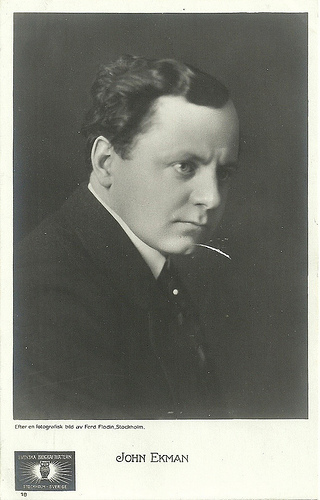
John Ekman. Swedish postcard by Svenska Biografteatern, Stockholm, no. 18. Photo: Ferd. Flodin, Stockholm.
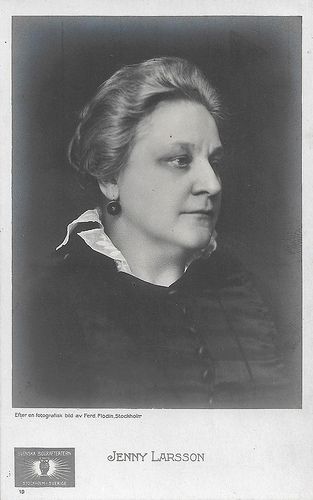
Jenny Larsson aka Jenny Tschernichin-Larsson. Swedish postcard by Svenska Biografteatern, Stockholm, no. 19. Photo: Ferd. Flodin, Stockholm.
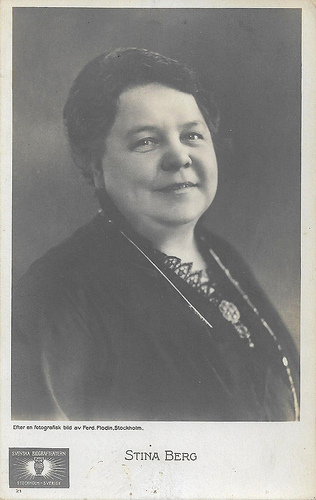
Stina Berg. Swedish postcard by Svenska Biografteatern, Stockholm, no. 21. Photo: Ferd. Flodin, Stockholm.
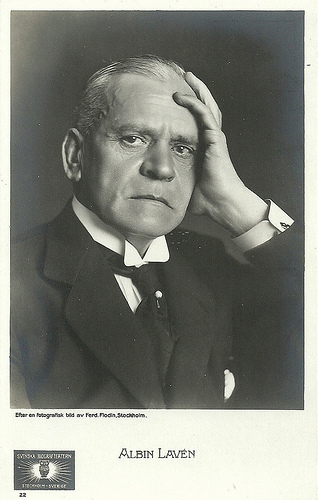
Albin Lavén. Swedish postcard by Svenska Biografteatern, Stockholm, no. 22. Photo: Ferd. Flodin, Stockholm.
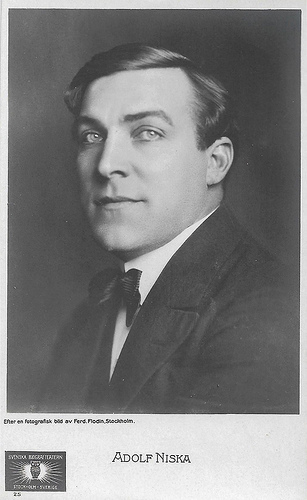
Adolf Niska. Swedish postcard by Svenska Biografteatern, Stockholm, no. 25. Photo: Ferd. Flodin, Stockholm.
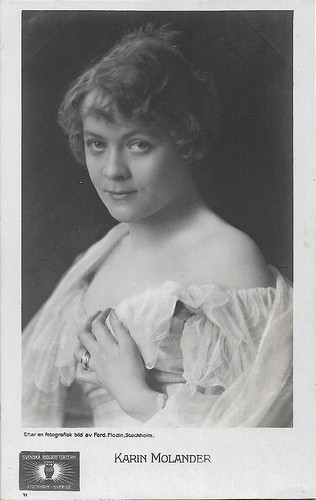
Karin Molander . Swedish postcard by Svenska Biografteatern, Stockholm, no. 71. Photo: Ferd. Flodin, Stockholm.
The earliest masterpiece in the Swedish silent film
In 1911 Svenska Bio moved to Lidingö, a municipality east of Stockholm. In 1912, three directors were working at the studio: Georg af Klercker, who was also the studio manager, and the stage directors Mauritz Stiller and Victor Sjöström. Magnusson had hired them both as actor-director. The two would become Sweden's most famous film pioneers.
Stiller and Sjöström came to record some sixty films in Lidingöateljén up until 1917. Ingeborg Holm (Victor Sjöström, 1913) is considered the earliest masterpiece in the Swedish silent film. The film tells the story of Ingeborg Holm who loses her mind when she loses her husband and children. The social commentary in the film lead to a heated debate about the shortcomings of poor care.
Other famous films made in Sweden during that time are Terje Vigen (Victor Sjöström, 1917) after a script by Gustaf Molander, Berg-Ejvind och hans hustru/The Outlaw and His Wife (Victor Sjöström, 1918), and Herr Arnes pengar/Sir Arne's Treasure (Mauritz Stiller, 1919) and others.
In 1914, the company began production and screenings of Svenska Bios weekly. These were the first Swedish film journals. In 1919 Svenska Bio bought land in Råsunda, where the studio planned to build a film city with two studios.
Later in 1919 the company joined forces with Filmindustri AB Skandia, founded a year before in 1918, to form the new Svensk Filmindustri AB. The new company, the biggest film studio in Sweden, had its entire business gathered in the newly built film town, and owned a portfolio of 70 cinemas, then one tenth of the total number of permanent cinemas in Sweden.
A year later, the name of the Svenska Bios weekly was changed to the SF journal and continued to be produced under its new name until 1960.
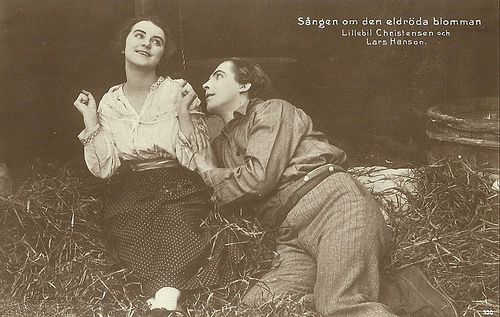
Swedish postcard by Nordisk Konst, Stockholm, no. 550. Photo: Svenska Biografteatern, Stockholm. Publicity still of Lars Hanson ' and Lillebil Christensen in Sängen om den eldröda blomman/The Song of the Red Flower (Mauritz Stiller, 1919).

Swedish postcard by Nordisk Konst, Stockholm, no. 843. Photo: Svenska Biografteatern AB. Publicity still for Tösen från Stormyrtorpet/The Girl from the Marsh Croft (Victor Sjöström, 1917), with Karin Molander . Caption: Hildur dressed up as bride.

Swedish postcard by Nordisk Konst, Stockholm, no. 844/8. Photo: Svenska Biografteatern AB. Publicity still of Victor Sjöström and Edith Erastoff in Berg-Ejvind och hans hustru/The Outlaw and His Wife (Victor Sjöström, 1918). Caption: Outside society.

Swedish postcard by Ed. Nordisk Konst, Stockholm, no. 876/3. Photo: Svenska Biografteatern AB. Publicity still for Thomas Graals bästa film/Thomas Graal's Best Film (Mauritz Stiller, 1917), with Victor Sjöström . Caption: The author Thomas Graal at sea.

Swedish postcard by Nordisk Konst, Stockholm, no. 877/1. Photo: Svenska Biografteatern AB. Publicity still for the comedy Alexander den Store/Alexander the Great (Mauritz Stiller, 1917) with Hauk Aabel and Stina Stockenstam. The story of the film deals with a provincial hotel cook, named Alexander the Great, in whose restaurant not only the dishes can be spicy. Caption: Alexander has rediscovered his beloved from his youth.
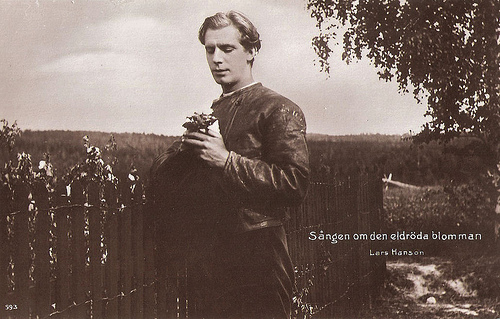
Swedish postcard by Forlag Nordisk Konst, Stockholm, no. 993. Photo: Svenska Biografteatern, Stockholm. Publicity still for Sången om den eldröda blomman/Flame of Life (Mauritz Stiller, 1919) with Lars Hanson '.

Swedish postcard by Nordisk Konst, Stockholm, no. 1078/8. Richard Lund, Bror Berger and Erik Stocklassa in Herr Arnes pengar/Sir Arne's Treasure (Mauritz Stiller, 1919). Caption: On the Lookout.

Swedish postcard by Förlag Nordisk Konst, Stockholm, no. 1092/15. Photo: Svenska Biografteatern. Publicity still for Klostret i Sendomir/The Monastery of Sendomir (Victor Sjöström, 1920) with Tore Svennberg and Tora Teje .
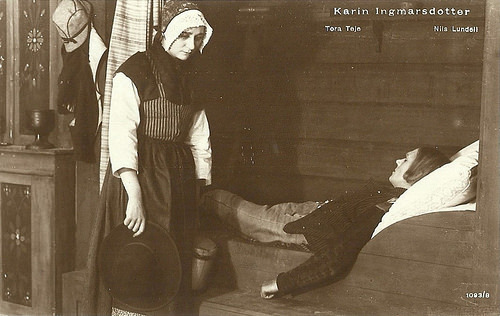
Swedish postcard by Nordisk Konst, Stockholm, no. 1093/8. Photo: Svenska Biografteatren AB. Publicity still for Karin Ingmarsdotter/God/s Way/Karin Daughter of Ingmar (Victor Sjöström, 1920), starring Tora Teje and with Nils Lundell. It is the second part in Sjöström's large-scale adaption of Selma Lagerlöf's novel 'Jerusalem', following Sons of Ingmar from the year before, and depicting chapter three and four from the novel.

Swedish postcard by Förlag Nordisk Konst, Stockholm, no. 1094/4. Photo: Svenska Biografteatern. Publicity still of Karin Molander and Egil Eide in Fiskebyn/The Fishing Village/Chains (Mauritz Stiller, 1920).
Sources: Douglas Gomery, Clara Pafort-Overduin (Movie History: A Survey), Nils Kim Gustafsson (Voodoo Film - Swedish), Wikipedia (Swedish) and .

Mary Johnson. Swedish postcard by Förlag Nordisk Konst, Stockholm, no. 1054. Photo: A.B. Svenska Biografteatern, Stockholm.

Harriet Bosse . Swedish postcard by Förlag Nordisk Konst, Stockholm, no. 1056. Photo: A.B. Svenska Biografteatern, Stockholm.

Lili Beck . Swedish postcard by Svenska Biografteatern, Stockholm, no. 10. Photo: Ferd. Flodin, Stockholm.

Victor Sjöström . Swedish postcard by Svenska Biografteatern, Stockholm, no. 12. Photo: Ferd. Flodin, Stockholm.

Richard Lund. Swedish postcard by Svenska Biografteatern, Stockholm, no. 13. Photo: Ferd. Flodin, Stockholm.

Swedish postcard by Svenska Biografteatern, Stockholm, no. 14. Photo: Ferd. Flodin, Stockholm. Lars Hanson 's last name is spelled Hansson on this card.
The first Swedish film studio
Sweden has only a small population, but no other country matched the fame of the Swedish cinema during the 1910s and 1920s. The main Swedish studio at the time was AB Svenska Biografteatern, or Svenska Bio.
AB Svenska Biografteatern was formed in 1907 through a conversion of Handelsbolaget Kristianstad Biograf-Teater with a share capital of SEK 150,000 and Nils H. Nylander as the first CEO. At first, the company owned about twenty cinemas and had 170 employees.
The company was based in Kristianstad and engaged in production, distribution and exhibition of films. Svenska Bio produced the first Swedish city films in 1907. These were films that portrayed the places where cinemas were opened.
In 1909, Charles Magnusson became the new CEO, and he would become the major, central figure in Swedish film life. Thanks to him, the number of cinemas grew to some forty around the country. AB Svenska Biografteatern inaugurated in March 1909 its newly built film palace in Kristianstad. In addition to the cinema Cosmorama (about 300 seats), the building also houses workshops, offices, film stores, laboratories and a film studio, that was Sweden's first. The film palace is now the Film Museum in Kristianstad.
Four years later Svenska Bio was the only major player in the Swedish production market. Pathé withdrew after a clash with the Swedish censorship board. Most smaller film companies went bankrupt when multiple film-reel became the new film mode. So Svenska Bio became a monopolist in Sweden and even began to export films to other European nations.

John Ekman. Swedish postcard by Svenska Biografteatern, Stockholm, no. 18. Photo: Ferd. Flodin, Stockholm.

Jenny Larsson aka Jenny Tschernichin-Larsson. Swedish postcard by Svenska Biografteatern, Stockholm, no. 19. Photo: Ferd. Flodin, Stockholm.

Stina Berg. Swedish postcard by Svenska Biografteatern, Stockholm, no. 21. Photo: Ferd. Flodin, Stockholm.

Albin Lavén. Swedish postcard by Svenska Biografteatern, Stockholm, no. 22. Photo: Ferd. Flodin, Stockholm.

Adolf Niska. Swedish postcard by Svenska Biografteatern, Stockholm, no. 25. Photo: Ferd. Flodin, Stockholm.

Karin Molander . Swedish postcard by Svenska Biografteatern, Stockholm, no. 71. Photo: Ferd. Flodin, Stockholm.
The earliest masterpiece in the Swedish silent film
In 1911 Svenska Bio moved to Lidingö, a municipality east of Stockholm. In 1912, three directors were working at the studio: Georg af Klercker, who was also the studio manager, and the stage directors Mauritz Stiller and Victor Sjöström. Magnusson had hired them both as actor-director. The two would become Sweden's most famous film pioneers.
Stiller and Sjöström came to record some sixty films in Lidingöateljén up until 1917. Ingeborg Holm (Victor Sjöström, 1913) is considered the earliest masterpiece in the Swedish silent film. The film tells the story of Ingeborg Holm who loses her mind when she loses her husband and children. The social commentary in the film lead to a heated debate about the shortcomings of poor care.
Other famous films made in Sweden during that time are Terje Vigen (Victor Sjöström, 1917) after a script by Gustaf Molander, Berg-Ejvind och hans hustru/The Outlaw and His Wife (Victor Sjöström, 1918), and Herr Arnes pengar/Sir Arne's Treasure (Mauritz Stiller, 1919) and others.
In 1914, the company began production and screenings of Svenska Bios weekly. These were the first Swedish film journals. In 1919 Svenska Bio bought land in Råsunda, where the studio planned to build a film city with two studios.
Later in 1919 the company joined forces with Filmindustri AB Skandia, founded a year before in 1918, to form the new Svensk Filmindustri AB. The new company, the biggest film studio in Sweden, had its entire business gathered in the newly built film town, and owned a portfolio of 70 cinemas, then one tenth of the total number of permanent cinemas in Sweden.
A year later, the name of the Svenska Bios weekly was changed to the SF journal and continued to be produced under its new name until 1960.

Swedish postcard by Nordisk Konst, Stockholm, no. 550. Photo: Svenska Biografteatern, Stockholm. Publicity still of Lars Hanson ' and Lillebil Christensen in Sängen om den eldröda blomman/The Song of the Red Flower (Mauritz Stiller, 1919).

Swedish postcard by Nordisk Konst, Stockholm, no. 843. Photo: Svenska Biografteatern AB. Publicity still for Tösen från Stormyrtorpet/The Girl from the Marsh Croft (Victor Sjöström, 1917), with Karin Molander . Caption: Hildur dressed up as bride.

Swedish postcard by Nordisk Konst, Stockholm, no. 844/8. Photo: Svenska Biografteatern AB. Publicity still of Victor Sjöström and Edith Erastoff in Berg-Ejvind och hans hustru/The Outlaw and His Wife (Victor Sjöström, 1918). Caption: Outside society.

Swedish postcard by Ed. Nordisk Konst, Stockholm, no. 876/3. Photo: Svenska Biografteatern AB. Publicity still for Thomas Graals bästa film/Thomas Graal's Best Film (Mauritz Stiller, 1917), with Victor Sjöström . Caption: The author Thomas Graal at sea.

Swedish postcard by Nordisk Konst, Stockholm, no. 877/1. Photo: Svenska Biografteatern AB. Publicity still for the comedy Alexander den Store/Alexander the Great (Mauritz Stiller, 1917) with Hauk Aabel and Stina Stockenstam. The story of the film deals with a provincial hotel cook, named Alexander the Great, in whose restaurant not only the dishes can be spicy. Caption: Alexander has rediscovered his beloved from his youth.

Swedish postcard by Forlag Nordisk Konst, Stockholm, no. 993. Photo: Svenska Biografteatern, Stockholm. Publicity still for Sången om den eldröda blomman/Flame of Life (Mauritz Stiller, 1919) with Lars Hanson '.

Swedish postcard by Nordisk Konst, Stockholm, no. 1078/8. Richard Lund, Bror Berger and Erik Stocklassa in Herr Arnes pengar/Sir Arne's Treasure (Mauritz Stiller, 1919). Caption: On the Lookout.

Swedish postcard by Förlag Nordisk Konst, Stockholm, no. 1092/15. Photo: Svenska Biografteatern. Publicity still for Klostret i Sendomir/The Monastery of Sendomir (Victor Sjöström, 1920) with Tore Svennberg and Tora Teje .

Swedish postcard by Nordisk Konst, Stockholm, no. 1093/8. Photo: Svenska Biografteatren AB. Publicity still for Karin Ingmarsdotter/God/s Way/Karin Daughter of Ingmar (Victor Sjöström, 1920), starring Tora Teje and with Nils Lundell. It is the second part in Sjöström's large-scale adaption of Selma Lagerlöf's novel 'Jerusalem', following Sons of Ingmar from the year before, and depicting chapter three and four from the novel.

Swedish postcard by Förlag Nordisk Konst, Stockholm, no. 1094/4. Photo: Svenska Biografteatern. Publicity still of Karin Molander and Egil Eide in Fiskebyn/The Fishing Village/Chains (Mauritz Stiller, 1920).
Sources: Douglas Gomery, Clara Pafort-Overduin (Movie History: A Survey), Nils Kim Gustafsson (Voodoo Film - Swedish), Wikipedia (Swedish) and .
Published on February 15, 2019 22:00
February 14, 2019
Renée Björling
Renée Björling (1888-1975) was a Swedish film and stage actress, who peaked in the Swedish silent cinema. Later she also played small parts in Ingmar Bergman's films and also in his stage plays.

Swedish postcard by Förlag Nordisk Konst, Stockholm, no. 1116/4. Renée Björling in the Swedish silent film Carolina Rediviva (1920), directed by Ivan Hedqvist, who also played one of the leads.

Swedish postcard by Förlag Nordisk Konst, no. 1190. Photo: Ferd. Flodin, Stockholm.

Swedish postcard by Förlag Nordisk Konst, Stockholm, no. 1275. Photo: M. Benkow, Atelier Kronen, Stockholm.

Swedish postcard by Exclusive Ljunggrens Konstförlag, Stockholm, No. 220. Photo: Atelier Gösta Hard.
The Quest for Happiness
Renée Louise Björling was born in 1888 in Lovö, Sweden. Her mother was actress Manda Björling (1876–1960). Her half-sister was opera singer Sigurd Björling (1907–1983).
Renée Björling debuted in 1909 on stage and studied stage acting in 1915-1917 at the Dramatens elevskola. Afterwards she acted at various theatres, e.g. the Nya Teatern, Lorensbergsteatern and the Kungliga Dramatiska Teatern (now Dramaten).
As film actress, she debuted in Fadren/Father (Anna Hofman-Uddgren, 1912), based on a play by August Strindberg. Björling played Bertha, daughter of the protagonist Adolf (August Falck). Afterwards she acted e.g. in the title role in Dunungen/The Quest for Happiness (Ivan Hedqvist, 1919) opposite Hedqvist himself, as Dortka in Victor Sjöström ’s Klostret i Sendomir/The Monastery of Sendomir (1920) with Tore Svennberg and Tora Teje , and as the lead of Carol[in]a in Carolina Rediviva (Ivan Hedqvist, 1920) with, again, Hedqvist himself.
Her silent career continued to flower with films such as En vildfagel/Give Me My Son (John W. Brunius, 1920) with Tore Svennberg, Vallfarten till Kevlaar/The Pilgrimage to Kevlaar (Ivan Hedqvist, 1921) with Torsten Bergström, and Fröken Fob (Elis Ellis, 1923) with Rudolph Forster.
Later films include Norrtullsligan/The Nurtull Gang (Per Lindberg, 1923) with Tora Teje , Carl XIIs Kurir/King Karl XII's Courier (Rudolph Antoni, 1924) with Gösta Ekman and Nils Asther, Livet pa landet/Life in the Country (Ivan Hedqvist, 1924), Halta Lena och Vindögda Per/Limping Lena and Cockeyed Peter (Sigur Wallén, 1925), and Tva konungar/Two Kings (Elis Ellis, 1925).
Her last silent parts were in the farce Charlis tant/Charlie's Aunt (Elis Ellis, 1926), and Gustav Wasa del I/Gustav Wasa, Part One (John W. Brunius, 1928) with Gösta Ekman in the lead.

Swedish postcard by Nordisk Konst, Stockholm, no. 1091/1. Publicity still for the Swedish silent film Dunungen/In Quest of Happiness (Ivan Hedqvist 1919), starring Renée Björling and Ragnar Widestedt.

Swedish postcard by Nordisk Konst, Stockholm, no. 1091/?. Photo: publicity still for the Swedish silent film Dunungen/In Quest of Happiness (Ivan Hedqvist, 1919), based on a novel by Selma Lagerlöf. The man in the middle is director Ivan Hedqvist as Theodor and the lady on the left is Jenny Tschernichin-Larsson, who plays Teodor's mother.

Swedish postcard by Nordisk Konst, Stockholm, no. 1091/10. Photo: publicity still for the Swedish silent film Dunungen/In Quest of Happiness (Ivan Hedqvist 1919), starring Renée Björling and Ivan Hedqvist.

Swedish postcard by Nordisk Konst, Stockholm, no. 1091/12. Publicity still for the Swedish silent film Dunungen/In Quest of Happiness (Ivan Hedqvist 1919), starring Renée Björling, Ivan Hedqvist and Ragnar Widestedt.
Ingmar Bergman
In the early 1930s, Renée Björling played parts in Vi som gar köksvägen/Servant's Entrance (Gustav Molander 1932) and the sequel Vi som går kjøkkenveien/We who walk the kitchen path (Tancred Ibsen, 1933). During the war years, Björling had two leads in Gustav Molander's Striden går vidare/The Fight Continues (1941) opposite Victor Sjöström , and in Släkten är bäst/The family is best (Ragnar Falck, 1944) with Sigurd Wallén.
Björling also appeared in small parts in several films of Ingmar Bergman. She was Aunt Elisabeth in Sommarlek/Summer Interlude (Ingmar Bergman, 1961) starring Maj-Britt Nilsson , and also appeared in Sommaren med Monika/Summer with Monica (Ingmar Bergman, 1953) starring Harriet Andersson, in En lektion i kärlek/A Lesson in Love (Ingmar Bergman, 1954) with Eva Dahlbeck, and in Kvinnodröm/Dreams (Ingmar Bergman, 1955). Bergman also directed Björling four times at the Dramaten, e.g. in 1964 in Ibsen's Hedda Gabler.
Among her later films were Sceningang/Stage Door (Bengt Ekerot, 1958), written by Erland Josephson, and Kvinnen i leopard/The Woman with the Fur Coat (Jan Molander, 1958), starring Harriet Andersson. She also acted twice on television, in the 1955 American TV series Foreign Intrigue, and as Mrs. Higgins in Pygmalion in 1968, starring Gunnar Björnstrand (Henry Higgins) and Harriet Andersson (Eliza Doolittle). On stage she had already played Mrs. Higgins at the Dramaten in 1952, opposite Lars Hanson and Anita Björk .
At the Dramaten, she acted in some 130 stage plays. Her partners included Gunnar Björnstrand (e.g. Molière's L'Avare in 1935), Lars Hanson (e.g. William Shakespeare's Romeo and Juliet in 1936), Anita Björk (e.g. L'Invitation au Château by Jean Anouilh in 1951), Jarl Kulle (e.g. in Aeschylus' Oresteia in 1954), or Gunn Wållgren (e.g. in Ivanov by Anton Chekhov in 1957).
Björling worked several times with Alf Sjöberg at Dramaten. First as an actor (e.g. in Madame Sans-Gêne by Victorien Sardou and Émile Moreau in 1927), and then as a director (e.g. in Les Mouches by Jean-Paul Sartre in 1945, with Stig Järrel and Mai Zetterling ), as well as Mimi Pollak, also as an actress (e.g. in The Cherry Orchard by Anton Chekhov in 1946) and as director (e.g. in A Flea in Her Air by Georges Feydeau in 1968).
Renée Björling stopped her film and TV career in 1968. She had played in some 40 silent and sound films. On stage, she performed for the last time at the Dramaten in 1971, in Euripides' Les Troyennes (in an adaptation by Jean-Paul Sartre), with Gunnel Lindblom and Mona Malm.
Renée Björling died in 1975 in Täby. She lies buried at Skogskyrkogården cemetery in Stockholm. From 1925 to 1932 she had been married to captain Gunnar Ursell and had a daughter Monica with him. Her granddaughter is opera singer Malena Ernman.

Swedish postcard by Förlag Nordisk Konst, Stockholm, no. 1092/3. Photo: publicity still for Klostret i Sendomir/The Monastery of Sendomir (Victor Sjöström, 1920) with Renée Björling and Tora Teje .

Swedish postcard by Förlag Nordisk Konst, Stockholm, no. 1092/4. Photo: publicity still for Klostret i Sendomir/The Monastery of Sendomir (Victor Sjöström, 1920) with Tora Teje and Renée Björling.

Swedish postcard by Nordisk Konst, Stockholm, no. 1116/1. Renée Björling and Richard Lund in Carolina Rediviva (Ivan Hedqvist, 1920).

Swedish postcard by Nordisk Konst, Stockholm, no. 1116/2. Photo: publicity still for Carolina Rediviva (Ivan Hedqvist, 1920) with Richard Lund.

Swedish postcard by Axel Eliassons Konstförlag, no.288, Stockholm. Photo: Skandia-Film / Svensk Filmindustri. Publicity still for the drama En vildfågel/My adopted son (John W. Brunius, 1921) with Pauline Brunius , Tore Svennberg, Renée Björling and Paul Seelig.
Sources: Svensk Filmdatabas (Swedish), Wikipedia (Swedish, English and German) and.

Swedish postcard by Förlag Nordisk Konst, Stockholm, no. 1116/4. Renée Björling in the Swedish silent film Carolina Rediviva (1920), directed by Ivan Hedqvist, who also played one of the leads.

Swedish postcard by Förlag Nordisk Konst, no. 1190. Photo: Ferd. Flodin, Stockholm.

Swedish postcard by Förlag Nordisk Konst, Stockholm, no. 1275. Photo: M. Benkow, Atelier Kronen, Stockholm.

Swedish postcard by Exclusive Ljunggrens Konstförlag, Stockholm, No. 220. Photo: Atelier Gösta Hard.
The Quest for Happiness
Renée Louise Björling was born in 1888 in Lovö, Sweden. Her mother was actress Manda Björling (1876–1960). Her half-sister was opera singer Sigurd Björling (1907–1983).
Renée Björling debuted in 1909 on stage and studied stage acting in 1915-1917 at the Dramatens elevskola. Afterwards she acted at various theatres, e.g. the Nya Teatern, Lorensbergsteatern and the Kungliga Dramatiska Teatern (now Dramaten).
As film actress, she debuted in Fadren/Father (Anna Hofman-Uddgren, 1912), based on a play by August Strindberg. Björling played Bertha, daughter of the protagonist Adolf (August Falck). Afterwards she acted e.g. in the title role in Dunungen/The Quest for Happiness (Ivan Hedqvist, 1919) opposite Hedqvist himself, as Dortka in Victor Sjöström ’s Klostret i Sendomir/The Monastery of Sendomir (1920) with Tore Svennberg and Tora Teje , and as the lead of Carol[in]a in Carolina Rediviva (Ivan Hedqvist, 1920) with, again, Hedqvist himself.
Her silent career continued to flower with films such as En vildfagel/Give Me My Son (John W. Brunius, 1920) with Tore Svennberg, Vallfarten till Kevlaar/The Pilgrimage to Kevlaar (Ivan Hedqvist, 1921) with Torsten Bergström, and Fröken Fob (Elis Ellis, 1923) with Rudolph Forster.
Later films include Norrtullsligan/The Nurtull Gang (Per Lindberg, 1923) with Tora Teje , Carl XIIs Kurir/King Karl XII's Courier (Rudolph Antoni, 1924) with Gösta Ekman and Nils Asther, Livet pa landet/Life in the Country (Ivan Hedqvist, 1924), Halta Lena och Vindögda Per/Limping Lena and Cockeyed Peter (Sigur Wallén, 1925), and Tva konungar/Two Kings (Elis Ellis, 1925).
Her last silent parts were in the farce Charlis tant/Charlie's Aunt (Elis Ellis, 1926), and Gustav Wasa del I/Gustav Wasa, Part One (John W. Brunius, 1928) with Gösta Ekman in the lead.

Swedish postcard by Nordisk Konst, Stockholm, no. 1091/1. Publicity still for the Swedish silent film Dunungen/In Quest of Happiness (Ivan Hedqvist 1919), starring Renée Björling and Ragnar Widestedt.

Swedish postcard by Nordisk Konst, Stockholm, no. 1091/?. Photo: publicity still for the Swedish silent film Dunungen/In Quest of Happiness (Ivan Hedqvist, 1919), based on a novel by Selma Lagerlöf. The man in the middle is director Ivan Hedqvist as Theodor and the lady on the left is Jenny Tschernichin-Larsson, who plays Teodor's mother.

Swedish postcard by Nordisk Konst, Stockholm, no. 1091/10. Photo: publicity still for the Swedish silent film Dunungen/In Quest of Happiness (Ivan Hedqvist 1919), starring Renée Björling and Ivan Hedqvist.

Swedish postcard by Nordisk Konst, Stockholm, no. 1091/12. Publicity still for the Swedish silent film Dunungen/In Quest of Happiness (Ivan Hedqvist 1919), starring Renée Björling, Ivan Hedqvist and Ragnar Widestedt.
Ingmar Bergman
In the early 1930s, Renée Björling played parts in Vi som gar köksvägen/Servant's Entrance (Gustav Molander 1932) and the sequel Vi som går kjøkkenveien/We who walk the kitchen path (Tancred Ibsen, 1933). During the war years, Björling had two leads in Gustav Molander's Striden går vidare/The Fight Continues (1941) opposite Victor Sjöström , and in Släkten är bäst/The family is best (Ragnar Falck, 1944) with Sigurd Wallén.
Björling also appeared in small parts in several films of Ingmar Bergman. She was Aunt Elisabeth in Sommarlek/Summer Interlude (Ingmar Bergman, 1961) starring Maj-Britt Nilsson , and also appeared in Sommaren med Monika/Summer with Monica (Ingmar Bergman, 1953) starring Harriet Andersson, in En lektion i kärlek/A Lesson in Love (Ingmar Bergman, 1954) with Eva Dahlbeck, and in Kvinnodröm/Dreams (Ingmar Bergman, 1955). Bergman also directed Björling four times at the Dramaten, e.g. in 1964 in Ibsen's Hedda Gabler.
Among her later films were Sceningang/Stage Door (Bengt Ekerot, 1958), written by Erland Josephson, and Kvinnen i leopard/The Woman with the Fur Coat (Jan Molander, 1958), starring Harriet Andersson. She also acted twice on television, in the 1955 American TV series Foreign Intrigue, and as Mrs. Higgins in Pygmalion in 1968, starring Gunnar Björnstrand (Henry Higgins) and Harriet Andersson (Eliza Doolittle). On stage she had already played Mrs. Higgins at the Dramaten in 1952, opposite Lars Hanson and Anita Björk .
At the Dramaten, she acted in some 130 stage plays. Her partners included Gunnar Björnstrand (e.g. Molière's L'Avare in 1935), Lars Hanson (e.g. William Shakespeare's Romeo and Juliet in 1936), Anita Björk (e.g. L'Invitation au Château by Jean Anouilh in 1951), Jarl Kulle (e.g. in Aeschylus' Oresteia in 1954), or Gunn Wållgren (e.g. in Ivanov by Anton Chekhov in 1957).
Björling worked several times with Alf Sjöberg at Dramaten. First as an actor (e.g. in Madame Sans-Gêne by Victorien Sardou and Émile Moreau in 1927), and then as a director (e.g. in Les Mouches by Jean-Paul Sartre in 1945, with Stig Järrel and Mai Zetterling ), as well as Mimi Pollak, also as an actress (e.g. in The Cherry Orchard by Anton Chekhov in 1946) and as director (e.g. in A Flea in Her Air by Georges Feydeau in 1968).
Renée Björling stopped her film and TV career in 1968. She had played in some 40 silent and sound films. On stage, she performed for the last time at the Dramaten in 1971, in Euripides' Les Troyennes (in an adaptation by Jean-Paul Sartre), with Gunnel Lindblom and Mona Malm.
Renée Björling died in 1975 in Täby. She lies buried at Skogskyrkogården cemetery in Stockholm. From 1925 to 1932 she had been married to captain Gunnar Ursell and had a daughter Monica with him. Her granddaughter is opera singer Malena Ernman.

Swedish postcard by Förlag Nordisk Konst, Stockholm, no. 1092/3. Photo: publicity still for Klostret i Sendomir/The Monastery of Sendomir (Victor Sjöström, 1920) with Renée Björling and Tora Teje .

Swedish postcard by Förlag Nordisk Konst, Stockholm, no. 1092/4. Photo: publicity still for Klostret i Sendomir/The Monastery of Sendomir (Victor Sjöström, 1920) with Tora Teje and Renée Björling.

Swedish postcard by Nordisk Konst, Stockholm, no. 1116/1. Renée Björling and Richard Lund in Carolina Rediviva (Ivan Hedqvist, 1920).

Swedish postcard by Nordisk Konst, Stockholm, no. 1116/2. Photo: publicity still for Carolina Rediviva (Ivan Hedqvist, 1920) with Richard Lund.

Swedish postcard by Axel Eliassons Konstförlag, no.288, Stockholm. Photo: Skandia-Film / Svensk Filmindustri. Publicity still for the drama En vildfågel/My adopted son (John W. Brunius, 1921) with Pauline Brunius , Tore Svennberg, Renée Björling and Paul Seelig.
Sources: Svensk Filmdatabas (Swedish), Wikipedia (Swedish, English and German) and.
Published on February 14, 2019 22:00
February 13, 2019
Richard Lund
Richard Lund (1885–1960) was a Swedish film and theatre actor, who had a prolific career in the films of Victor Sjöström and Mauritz Stiller. He starred in such Swedish silent films as Herr Arnes pengar/Sir Arne's Treasure (Mauritz Stiller, 1919).

Swedish postcard by Svenska Biografteatern, no. 12. Photo: Ferd. Flodin, Stockholm.

Swedish postcard by Förlag Nordisk Konst, Stockholm, no 1078/1. Richard Lund as Sir Archi(e) in Herr Arnes pengar/Sir Arne's Treasure (Mauritz Stiller, 1919).
The first film that influenced the public debate
Richard Lund was born in Göteborg (Gothenburg), Sweden, in 1885.
He made his stage debut at the Stora Teatern (The Old Theatre) in Göteborg in 1904. He later came to work in ensembles under such varied theatre directors as Hjalmar Selander, Ivan Hedqvist and Karl Gerhard. In 1909 he played in a stage adaptation of Maurice Leblanc’s Arsène Lupin at the Stockholm Oscarteatern.
In 1912 Lund began his – long-lasting - career as a film actor and would appear in 73 films between 1912 and 1952. He played his most important roles during the silent film era. He debuted at the company Svenska Biografteatern in Victor Sjöström ’s film Ett hemligt giftermål eller Bekännelsen på dödsbädden/A Secret Marriage or Confession on His Deathbed (1912), distributed in the US as A Ruined Life, and with Hilda Borgström in the female lead. The film also was the debut for actress Greta Almroth.
Lund became a regular at Svenska Bio, often cast as the young, handsome love interest. In 1913 he acted in Mauritz Stiller’s smuggler’s drama På livets ödesvägar/The Smugglers/ The Fisherman’s Son (1913) with the Danish actors Carlo and Clara Wieth . It was followed by a series of films by Victor Sjöström : Löjen och tårar/Laughter and Tears (1913), Livets konflikter/The Conflicts of Life (1913), Lady Marions sommarflirt/Lady Marion's Summer Flirtation (1913), and Ingeborg Holm (1913). Apart from Löjen och tårar, Hilda Borgström was his co-star in all these films.
Mauritz Stiller directed Richard Lund in the films Gränsfolken/Brother against Brother (1913) and Den moderna suffragetten/The Modern Suffragette (1913). Then followed Blodets röst/The Voice of Passion (Victor Sjöström, 1913) with Sjöström himself in the lead.
While many of these films are lost, Ingeborg Holm (Victor Sjöström, 1913) remains and shows the troubles of a grocer’s widow (Hilda Borgström) who falls down the social ladder and is forced to move to the poor house where her children are taken from her. Lund plays the doctor at the poor house. With its social critique, it was the first film in Sweden - and possibly globally - that influenced the public debate and brought about changes. It is also remarkable for its restrained performance and sophisticated staging.

Swedish postcard by Ljunggrens Konstförlag, Stockholm, no. 212. Photo: Atelier Gösta Hard.

Swedish postcard by Ljunggrens Konstförlag, Stockholm, no. 213. Photo: Atelier Gösta Hard.
An incomplete copy found in Zaragoza
In 1914, Richard Lund’s career at Svenska Bio was confirmed in 1914 with Stormfågeln/Stormy Petrel (Mauritz Stiller, 1914) starring Lilli Bech (or Beck), and För sin kärleks skull/Because of Her Love (1914) with Lilli Bech and Victor Sjöström.
That year, he also appeared in five films by Victor Sjöström : Prästen/The Clergyman (1914) with Egil Eide and Clara Wieth , Kärlek starkare än hat eller Skogsdotterns hemlighet/The Poacher (1914) with John Ekman, Hjärtan som mötas/Hearts That Meet (1914) with Alfred Lundberg and Karin Molander , Dömen icke/Judge Not (1914) with Nils Arehn and Hilda Borgström, and Bra flicka reder sig själv/A Good Girl Keeps Herself in Good Order (1914) with Clara Wieth .
In 1915 followed ten new films. Lund made again five films with Sjöström: Strejken/The Strike (1915), Skomakare, bliv vid din läst/Stick to Your Last, Shoemaker (1915), Landshövdingens döttrar/The Governor's Daughters (1915), I prövningens stund/In the Hour of Trial (1915), and Det var i maj/It Was in May (1915).
He also made four films with Mauritz Stiller: Lekkamraterna/Playmates (1915), Hämnaren/The Avenger (1915), Hans hustrus förflutna/His Wife's Past (1915), Hans bröllopsnatt/His Wedding Night (1915). He also appeared in Hans faders brott/His Father's Crime (Fritz Magnussen, 1915).
From 1916, the number of films in which Lund played went down but some of his most memorable film titles date from the late 1910s and early 1920s. In 1916, he played in Lyckonålen/The Lucky Brooch (Mauritz Stiller, 1916), Kärlek och journalistik/Love and Journalism (Mauritz Stiller, 1916), Kampen om hans hjärta/The Fight for His Heart (Mauritz Stiller, 1916) and Havsgamar/Predators of the Sea (Victor Sjöström, 1916).
Lund also acted Balettprimadonnan/Anjala the Dancer (Mauritz Stiller, 1916) opposite the debuting Jenny Hasselqvist and rising star Lars Hanson , who had debuted in 1915. The film deals with a violin player (Hanson) who discovers a peasant girl (Hasselqvist) and promotes her as a dancer but a scheming count (Lund) separates the two by offering the violin player a training abroad. Balettprimadonnan was an international success and distributed all over the world. Two copies of the film sent by ship to England disappeared when the ship was torpedoed and sunk in autumn 1917. The film was long considered as lost, but in 1995 an incomplete copy of the film was found in Zaragoza in Spain and restored and reconstructed, using still images and copyright information.

Swedish postcard by Nordisk Konst, Stockholm, no. 1078/8. Richard Lund, Bror Berger and Erik Stocklassa in Herr Arnes pengar/Sir Arne's Treasure (Mauritz Stiller, 1919). Caption: On the Lookout.

Swedish postcard by Nordisk Konst, Stockholm, no. 1078/12. Richard Lund and Mary Johnson in the Swedish silent film Herr Arnes pengar/Sir Arne's Treasure (Mauritz Stiller, 1919). Caption: They have come now to arrest you, escape!
The Masterpiece of the Swedish Silent Cinema
In 1917, Richard Lund did not act in any films by Stiller nor Sjöström, but instead in two by Fritz Magnussen, one by Egil Eide (who had become director) and two by Konrad Tallroth. No films with Lund were released in 1918.
In 1919, Lund appeared in his best-known film role, that of Sir Archie in Herr Arnes pengar/Sir Arne's Treasure (Mauritz Stiller, 1919). In this crime-drama based on Selma Lagerlöf’s novel 'The Treasure', and set on the Swedish coast in the 16th century, Lund is a Scottish mercenary who, together with his cronies Sir Donald (Bro Berger) and Sir Filip (Erich Stocklassa), has escaped from a Scottish prison and fled to Sweden. There, he murders the family of Sir Arne to obtain a treasure, after which he unknowingly starts an affair with the daughter of the murdered family, Elsalill (Mary Johnson).
Sir Arne’s Treasure still goes as one of - if not the - masterpiece(s) of the Swedish silent cinema. Jerzy Toeplitz wrote in his 'Geschichte des Films' (1972): “As with Sjöström, Nature plays a leading role in Stiller's film. Already in the first images, the snow creates the atmosphere of the action. In the tragic finale, the sea becomes a contributor. In the small port of Marstrand lies the ship that should return the Scots to their home. But it is wedged by ice floes.
When the situation is strained to the utmost because the forces of nature cannot be conquered, in the city the news spreads that the criminals want to flee. In the battle with the town guards, Elsalill dies and Sir John Archie is captured. A long train of gray-clad women arrives at the ship to take off the corpse of Elsalill, after which the ice bursts and the occupied ship begins to move. Too late the silent, dangerous sea shows up.”
Next, Lund acted as the antagonist in Klostret i Sendomir/The Monastery of Sendomir (Victor Sjöström, 1920), based on an 1828 short story by Franz Grillparzer. It deals with a monk (Tore Svennberg) who tells two visitors how the convent was built by a repentant count who killed his unfaithful and treacherous wife ( Tora Teje ) after he had discovered she had a long-standing affair with her cousin Oleg (Richard Lund) and even his child was not his own. The monk proves to be the count himself. In Germany a competing version was made in 1919 by Union, starring Ellen Richter and Eduard von Winterstein, and causing a fierce battle over the release over the two films in Sweden.

Swedish postcard by Förlag Nordisk Konst, Stockholm, no. 1092/6. Photo: publicity still for Klostret i Sendomir/The Monastery of Sendomir (Victor Sjöström, 1920) with Tora Teje and Richard Lund.

Swedish postcard by Förlag Nordisk Konst, Stockholm, no. 1092/11. Photo: publicity still for Klostret i Sendomir/The Monastery of Sendomir (Victor Sjöström, 1920) with Tore Svennberg, Richard Lund and Tora Teje .
A foundling left at the university gate
Richard Lund’s following film was Carolina Rediviva (Ivan Hedqvist, 1920), a film set in the Uppsala university world, in which Renée Björling plays a foundling, whose mother Lina has left her at the university gate, to be adopted by students, and whose identity once revealed causes scandal in the academic world. Lund is Björling’s love interest.
In Det omringade huset/The Surrounded House (Victor Sjöström, 1922). Lund was the brother of the leading character Mary (Meggie Albanesi), while co-actors were Victor Sjöström , Uno Henning and Ivan Hedqvist. Lund’s last silent films were Livet på landet/Life in the Country (Ivan Hedqvist, 1924), Farbror Frans/Uncle Frans (Sigurd Wallén, 1926), and Dollarmillionen (Sigurd Wallén, 1926).
Lund easily made the passage to Swedish sound cinema, starting with Konstgjorda Svensson (Gustaf Edgren, 1929), although that was a part-talkie. Lund also had a major part in Hjärtats röst (Rune Carlsen, 1930), shot at Les Studios Paramount outside Paris, and based on Alden Arthur Knipes’ novel 'Sarah and Son', which had been filmed in the US under its original title in 1930 by Dorothy Arzner.
However, in the 1930s Lund’s prime was past and his parts became smaller as in Valborgsmässoafton/Walpurgis Night (Gustav Edgren 1935), starring Lars Hanson , Victor Sjöström and a young Ingrid Bergman . Until 1952 Lund continued to act small parts, even uncredited, in Swedish sound films, all in all, some 35 films from 1930 onwards.
Still, it was clear Richard Lund had peaked in the silent era of the 1910s and early 1920s. Lund died in Mölndal in 1960.

Swedish postcard by Nordisk Konst, Stockholm, no. 1116/1. Photo: publicity still of Renée Björling and Richard Lund in Carolina Rediviva (1920), directed by Ivan Hedqvist, who also played one of the leads.

Swedish postcard by Nordisk Konst, Stockholm, no. 1116/2. Photo: publicity still for Carolina Rediviva (Ivan Hedqvist, 1920) with Renée Björling and Richard Lund.

Swedish postcard by Axel Eliassons Konstförlag, Stockholm, no. 255. Photo: Gösta Hard.
Sources: The Swedish Film database, Wikipedia (Swedish and English), and .

Swedish postcard by Svenska Biografteatern, no. 12. Photo: Ferd. Flodin, Stockholm.

Swedish postcard by Förlag Nordisk Konst, Stockholm, no 1078/1. Richard Lund as Sir Archi(e) in Herr Arnes pengar/Sir Arne's Treasure (Mauritz Stiller, 1919).
The first film that influenced the public debate
Richard Lund was born in Göteborg (Gothenburg), Sweden, in 1885.
He made his stage debut at the Stora Teatern (The Old Theatre) in Göteborg in 1904. He later came to work in ensembles under such varied theatre directors as Hjalmar Selander, Ivan Hedqvist and Karl Gerhard. In 1909 he played in a stage adaptation of Maurice Leblanc’s Arsène Lupin at the Stockholm Oscarteatern.
In 1912 Lund began his – long-lasting - career as a film actor and would appear in 73 films between 1912 and 1952. He played his most important roles during the silent film era. He debuted at the company Svenska Biografteatern in Victor Sjöström ’s film Ett hemligt giftermål eller Bekännelsen på dödsbädden/A Secret Marriage or Confession on His Deathbed (1912), distributed in the US as A Ruined Life, and with Hilda Borgström in the female lead. The film also was the debut for actress Greta Almroth.
Lund became a regular at Svenska Bio, often cast as the young, handsome love interest. In 1913 he acted in Mauritz Stiller’s smuggler’s drama På livets ödesvägar/The Smugglers/ The Fisherman’s Son (1913) with the Danish actors Carlo and Clara Wieth . It was followed by a series of films by Victor Sjöström : Löjen och tårar/Laughter and Tears (1913), Livets konflikter/The Conflicts of Life (1913), Lady Marions sommarflirt/Lady Marion's Summer Flirtation (1913), and Ingeborg Holm (1913). Apart from Löjen och tårar, Hilda Borgström was his co-star in all these films.
Mauritz Stiller directed Richard Lund in the films Gränsfolken/Brother against Brother (1913) and Den moderna suffragetten/The Modern Suffragette (1913). Then followed Blodets röst/The Voice of Passion (Victor Sjöström, 1913) with Sjöström himself in the lead.
While many of these films are lost, Ingeborg Holm (Victor Sjöström, 1913) remains and shows the troubles of a grocer’s widow (Hilda Borgström) who falls down the social ladder and is forced to move to the poor house where her children are taken from her. Lund plays the doctor at the poor house. With its social critique, it was the first film in Sweden - and possibly globally - that influenced the public debate and brought about changes. It is also remarkable for its restrained performance and sophisticated staging.

Swedish postcard by Ljunggrens Konstförlag, Stockholm, no. 212. Photo: Atelier Gösta Hard.

Swedish postcard by Ljunggrens Konstförlag, Stockholm, no. 213. Photo: Atelier Gösta Hard.
An incomplete copy found in Zaragoza
In 1914, Richard Lund’s career at Svenska Bio was confirmed in 1914 with Stormfågeln/Stormy Petrel (Mauritz Stiller, 1914) starring Lilli Bech (or Beck), and För sin kärleks skull/Because of Her Love (1914) with Lilli Bech and Victor Sjöström.
That year, he also appeared in five films by Victor Sjöström : Prästen/The Clergyman (1914) with Egil Eide and Clara Wieth , Kärlek starkare än hat eller Skogsdotterns hemlighet/The Poacher (1914) with John Ekman, Hjärtan som mötas/Hearts That Meet (1914) with Alfred Lundberg and Karin Molander , Dömen icke/Judge Not (1914) with Nils Arehn and Hilda Borgström, and Bra flicka reder sig själv/A Good Girl Keeps Herself in Good Order (1914) with Clara Wieth .
In 1915 followed ten new films. Lund made again five films with Sjöström: Strejken/The Strike (1915), Skomakare, bliv vid din läst/Stick to Your Last, Shoemaker (1915), Landshövdingens döttrar/The Governor's Daughters (1915), I prövningens stund/In the Hour of Trial (1915), and Det var i maj/It Was in May (1915).
He also made four films with Mauritz Stiller: Lekkamraterna/Playmates (1915), Hämnaren/The Avenger (1915), Hans hustrus förflutna/His Wife's Past (1915), Hans bröllopsnatt/His Wedding Night (1915). He also appeared in Hans faders brott/His Father's Crime (Fritz Magnussen, 1915).
From 1916, the number of films in which Lund played went down but some of his most memorable film titles date from the late 1910s and early 1920s. In 1916, he played in Lyckonålen/The Lucky Brooch (Mauritz Stiller, 1916), Kärlek och journalistik/Love and Journalism (Mauritz Stiller, 1916), Kampen om hans hjärta/The Fight for His Heart (Mauritz Stiller, 1916) and Havsgamar/Predators of the Sea (Victor Sjöström, 1916).
Lund also acted Balettprimadonnan/Anjala the Dancer (Mauritz Stiller, 1916) opposite the debuting Jenny Hasselqvist and rising star Lars Hanson , who had debuted in 1915. The film deals with a violin player (Hanson) who discovers a peasant girl (Hasselqvist) and promotes her as a dancer but a scheming count (Lund) separates the two by offering the violin player a training abroad. Balettprimadonnan was an international success and distributed all over the world. Two copies of the film sent by ship to England disappeared when the ship was torpedoed and sunk in autumn 1917. The film was long considered as lost, but in 1995 an incomplete copy of the film was found in Zaragoza in Spain and restored and reconstructed, using still images and copyright information.

Swedish postcard by Nordisk Konst, Stockholm, no. 1078/8. Richard Lund, Bror Berger and Erik Stocklassa in Herr Arnes pengar/Sir Arne's Treasure (Mauritz Stiller, 1919). Caption: On the Lookout.

Swedish postcard by Nordisk Konst, Stockholm, no. 1078/12. Richard Lund and Mary Johnson in the Swedish silent film Herr Arnes pengar/Sir Arne's Treasure (Mauritz Stiller, 1919). Caption: They have come now to arrest you, escape!
The Masterpiece of the Swedish Silent Cinema
In 1917, Richard Lund did not act in any films by Stiller nor Sjöström, but instead in two by Fritz Magnussen, one by Egil Eide (who had become director) and two by Konrad Tallroth. No films with Lund were released in 1918.
In 1919, Lund appeared in his best-known film role, that of Sir Archie in Herr Arnes pengar/Sir Arne's Treasure (Mauritz Stiller, 1919). In this crime-drama based on Selma Lagerlöf’s novel 'The Treasure', and set on the Swedish coast in the 16th century, Lund is a Scottish mercenary who, together with his cronies Sir Donald (Bro Berger) and Sir Filip (Erich Stocklassa), has escaped from a Scottish prison and fled to Sweden. There, he murders the family of Sir Arne to obtain a treasure, after which he unknowingly starts an affair with the daughter of the murdered family, Elsalill (Mary Johnson).
Sir Arne’s Treasure still goes as one of - if not the - masterpiece(s) of the Swedish silent cinema. Jerzy Toeplitz wrote in his 'Geschichte des Films' (1972): “As with Sjöström, Nature plays a leading role in Stiller's film. Already in the first images, the snow creates the atmosphere of the action. In the tragic finale, the sea becomes a contributor. In the small port of Marstrand lies the ship that should return the Scots to their home. But it is wedged by ice floes.
When the situation is strained to the utmost because the forces of nature cannot be conquered, in the city the news spreads that the criminals want to flee. In the battle with the town guards, Elsalill dies and Sir John Archie is captured. A long train of gray-clad women arrives at the ship to take off the corpse of Elsalill, after which the ice bursts and the occupied ship begins to move. Too late the silent, dangerous sea shows up.”
Next, Lund acted as the antagonist in Klostret i Sendomir/The Monastery of Sendomir (Victor Sjöström, 1920), based on an 1828 short story by Franz Grillparzer. It deals with a monk (Tore Svennberg) who tells two visitors how the convent was built by a repentant count who killed his unfaithful and treacherous wife ( Tora Teje ) after he had discovered she had a long-standing affair with her cousin Oleg (Richard Lund) and even his child was not his own. The monk proves to be the count himself. In Germany a competing version was made in 1919 by Union, starring Ellen Richter and Eduard von Winterstein, and causing a fierce battle over the release over the two films in Sweden.

Swedish postcard by Förlag Nordisk Konst, Stockholm, no. 1092/6. Photo: publicity still for Klostret i Sendomir/The Monastery of Sendomir (Victor Sjöström, 1920) with Tora Teje and Richard Lund.

Swedish postcard by Förlag Nordisk Konst, Stockholm, no. 1092/11. Photo: publicity still for Klostret i Sendomir/The Monastery of Sendomir (Victor Sjöström, 1920) with Tore Svennberg, Richard Lund and Tora Teje .
A foundling left at the university gate
Richard Lund’s following film was Carolina Rediviva (Ivan Hedqvist, 1920), a film set in the Uppsala university world, in which Renée Björling plays a foundling, whose mother Lina has left her at the university gate, to be adopted by students, and whose identity once revealed causes scandal in the academic world. Lund is Björling’s love interest.
In Det omringade huset/The Surrounded House (Victor Sjöström, 1922). Lund was the brother of the leading character Mary (Meggie Albanesi), while co-actors were Victor Sjöström , Uno Henning and Ivan Hedqvist. Lund’s last silent films were Livet på landet/Life in the Country (Ivan Hedqvist, 1924), Farbror Frans/Uncle Frans (Sigurd Wallén, 1926), and Dollarmillionen (Sigurd Wallén, 1926).
Lund easily made the passage to Swedish sound cinema, starting with Konstgjorda Svensson (Gustaf Edgren, 1929), although that was a part-talkie. Lund also had a major part in Hjärtats röst (Rune Carlsen, 1930), shot at Les Studios Paramount outside Paris, and based on Alden Arthur Knipes’ novel 'Sarah and Son', which had been filmed in the US under its original title in 1930 by Dorothy Arzner.
However, in the 1930s Lund’s prime was past and his parts became smaller as in Valborgsmässoafton/Walpurgis Night (Gustav Edgren 1935), starring Lars Hanson , Victor Sjöström and a young Ingrid Bergman . Until 1952 Lund continued to act small parts, even uncredited, in Swedish sound films, all in all, some 35 films from 1930 onwards.
Still, it was clear Richard Lund had peaked in the silent era of the 1910s and early 1920s. Lund died in Mölndal in 1960.

Swedish postcard by Nordisk Konst, Stockholm, no. 1116/1. Photo: publicity still of Renée Björling and Richard Lund in Carolina Rediviva (1920), directed by Ivan Hedqvist, who also played one of the leads.

Swedish postcard by Nordisk Konst, Stockholm, no. 1116/2. Photo: publicity still for Carolina Rediviva (Ivan Hedqvist, 1920) with Renée Björling and Richard Lund.

Swedish postcard by Axel Eliassons Konstförlag, Stockholm, no. 255. Photo: Gösta Hard.
Sources: The Swedish Film database, Wikipedia (Swedish and English), and .
Published on February 13, 2019 22:00
February 12, 2019
The Rise of Catherine the Great (1934)
The Rise of Catherine the Great (1934) was the first English-language film for Vienna-born Elisabeth Bergner. The historical film was directed by Bergner's husband Paul Czinner and - uncredited - by producer Alexander Korda. Tsar Peter was played by Douglas Fairbanks Junior. Although the film was overshadowed by Josef von Strernberg's masterpiece The Scarlet Empress (1934) with Marlene Dietrich, The Rise of Catherine the Great is a good film taken on its own merits.

British postcard by De Reszke Cigarettes, no. 24. Photo: British and Dominions. Publicity still for The Rise of Catherine the Great (Paul Czinner, 1934) with Elisabeth Bergner .

British postcard by Valentine's, no. 5904 N. Photo: London Films. Publicity still for The Rise of Catherine the Great (Paul Czinner, 1934) with Douglas Fairbanks Jr.
The way to the assumption of the throne
The Rise of Catherine the Great (Paul Czinner, 1934) is a straightforward biography of the Russian empress, up to her assumption of the throne. It was based on the play The Czarina by two Hungarian writers, Lajos Bíró and Melchior Lengyel.
In 1745 a German princess, Princess Sophie Auguste Frederika of Anhalt-Zerbst ( Elisabeth Bergner ), is summoned by Russian Empress Elizabeth ( Flora Robson ) to marry her nephew, the Russian heir. Elizabeth chose Sophie because of dynastic claims to Swedish and Baltic territories of the Romanov Family dealing with their Holstein blood connections - connections that Anhalt-Zerbst shared.
The young princess arrives at the court of imperial Russia to marry Grand Duke Pyotr ( Douglas Fairbanks Jr. ), who later became Peter III. Sophie, renamed Yekaterina, generally rendered in English as Catherine, initially likes him. But Peter already displays signs of mental instability and a sharply misogynist streak.
Peter rejects Catherine on their wedding night, reacting to something innocently said by his French valet, claiming that she used feminine tricks to win him over. In time, though, Peter accepts her and they have a happy marriage for a while. Meanwhile, Catherine gains important experience of government from working as principal aide to the empress.
Peter's suspicious, unstable nature gradually estranges them, and he finds solace with pretty courtiers. Catherine invents her own fictitious lovers, to make her husband jealous, which temporarily improves matters. But accession to the throne brings out the worst in Peter. After the death of the old Empress, the danger for Catherine increases and she must learn to be very cunning in order to save herself from her insane royal husband.
In reality, Catherine and Peter's marriage lasted for seventeen years, but in the film this period is greatly telescoped and no mention is made of their children. Their son Paul eventually became Tsar after Catherine's death, even though he was nearly as mad as his father.
Peter ascended the throne in 1762. As the Tsar, he proved to be a disaster, and within a few months he was removed from power by a military coup, dying in mysterious circumstances shortly afterwards. The coup plotters invited Catherine to become Empress in her own right. Catherine became the Tsarina Catherine the Great and would rule over Russia for more than 30 years. She became a benign dictator, brought Russia into the modern world, implemented several reforms, and corresponded with Voltaire.

British postcard in the Filmshots series by Film Weekly. Photo: London Films. Publicity still for The Rise of Catherine the Great (Paul Czinner, 1934). Although the postcard credits the kissing lady as Elisabeth Bergner , we think she is Diana Napier who portrays Countess Vorontzova, the mistress of Peter III ( Douglas Fairbanks Jr. ).

British postcard in the Filmshots series by Film Weekly. Photo: London Films. Publicity still for The Rise of Catherine the Great (Paul Czinner, 1934) with Douglas Fairbanks Jr. and Diana Napier.
A homicidal Hamlet
The Rise of Catherine the Great (1934) was the first English-language film for Vienna-born Elisabeth Bergner . She is radiant as the obscure German princess who would become the most powerful woman in Russian history. Bergner definitely makes Catherine interesting and worth caring about.
As Grand Duke Peter - later Czar Peter III - Douglas Fairbanks Jr. behaves like a homicidal Hamlet, all moodiness and flares of deadly temper. He makes an interesting effort to create a charmer out of a pathetic man who was obviously a maniac.
The supporting cast is excellent. Dame Flora Robson is wonderful as the Empress Elizabeth: suspicious, domineering and rather wanton. Robson portrays Tsarina Elizabeth as a tired, dying woman, desperate to try to save the dynasty and her nation but aware of the rotten material she has to work with. She has the best lines and delivers them impressively.
Celebrated stage actress Dame Irene Vanbrugh makes a rare screen appearance as Catherine's mother. Vanbrugh was a stage star of the 1890s till the 1920s. She was in the original cast of The Importance of Being Earnest by Oscar Wilde. The small role of Peter's French valet is performed by Sir Gerald du Maurier, one of the great English actor-managers of the early days of the century. In this, his penultimate role, a few months from his death, Sir Gerald had become largely forgotten by his once enormous public. He gives his few lines great dignity.
The mid-eighteenth century was a period when clothes and furnishings favoured by the wealthy classes of Europe were particularly fanciful and elaborate, and this is reflected in the lavish sets and costumes on view in the film.
The Rise of Catherine the Great (1934) was overshadowed by the Hollywood epic The Scarlet Empress (1934), directed by Joseph Von Sternberg and starring a glamorous Marlene Dietrich . However, The Rise of Catherine the Great is still a good effort that is worth watching.

British postcard in the Filmshots series by Film Weekly. Photo: London Films. Publicity still for The Rise of Catherine the Great (Paul Czinner, 1934) with Irene Vanbrugh as Princess Anhalt-Zerbst, and Elisabeth Bergner .

British postcard in the Filmshots series by Film Weekly. Photo: London Films. Publicity still for The Rise of Catherine the Great (Paul Czinner, 1934) with Douglas Fairbanks Jr. , Flora Robson as Empress Elizabeth, and Elisabeth Bergner .

Elisabeth Bergner. British cigarette card in the Stars of Screen & Stage series by Park Drive Cigarettes, Gallaher Ltd., London & Belfast, no. 17. Photo: London Films. Publicity still for The Rise of Catherine the Great (Paul Czinner, 1934). Collection: Geoffrey Donaldson Institute.
Sources: Ron Oliver (IMDb), Wikipedia and IMDb.

British postcard by De Reszke Cigarettes, no. 24. Photo: British and Dominions. Publicity still for The Rise of Catherine the Great (Paul Czinner, 1934) with Elisabeth Bergner .

British postcard by Valentine's, no. 5904 N. Photo: London Films. Publicity still for The Rise of Catherine the Great (Paul Czinner, 1934) with Douglas Fairbanks Jr.
The way to the assumption of the throne
The Rise of Catherine the Great (Paul Czinner, 1934) is a straightforward biography of the Russian empress, up to her assumption of the throne. It was based on the play The Czarina by two Hungarian writers, Lajos Bíró and Melchior Lengyel.
In 1745 a German princess, Princess Sophie Auguste Frederika of Anhalt-Zerbst ( Elisabeth Bergner ), is summoned by Russian Empress Elizabeth ( Flora Robson ) to marry her nephew, the Russian heir. Elizabeth chose Sophie because of dynastic claims to Swedish and Baltic territories of the Romanov Family dealing with their Holstein blood connections - connections that Anhalt-Zerbst shared.
The young princess arrives at the court of imperial Russia to marry Grand Duke Pyotr ( Douglas Fairbanks Jr. ), who later became Peter III. Sophie, renamed Yekaterina, generally rendered in English as Catherine, initially likes him. But Peter already displays signs of mental instability and a sharply misogynist streak.
Peter rejects Catherine on their wedding night, reacting to something innocently said by his French valet, claiming that she used feminine tricks to win him over. In time, though, Peter accepts her and they have a happy marriage for a while. Meanwhile, Catherine gains important experience of government from working as principal aide to the empress.
Peter's suspicious, unstable nature gradually estranges them, and he finds solace with pretty courtiers. Catherine invents her own fictitious lovers, to make her husband jealous, which temporarily improves matters. But accession to the throne brings out the worst in Peter. After the death of the old Empress, the danger for Catherine increases and she must learn to be very cunning in order to save herself from her insane royal husband.
In reality, Catherine and Peter's marriage lasted for seventeen years, but in the film this period is greatly telescoped and no mention is made of their children. Their son Paul eventually became Tsar after Catherine's death, even though he was nearly as mad as his father.
Peter ascended the throne in 1762. As the Tsar, he proved to be a disaster, and within a few months he was removed from power by a military coup, dying in mysterious circumstances shortly afterwards. The coup plotters invited Catherine to become Empress in her own right. Catherine became the Tsarina Catherine the Great and would rule over Russia for more than 30 years. She became a benign dictator, brought Russia into the modern world, implemented several reforms, and corresponded with Voltaire.

British postcard in the Filmshots series by Film Weekly. Photo: London Films. Publicity still for The Rise of Catherine the Great (Paul Czinner, 1934). Although the postcard credits the kissing lady as Elisabeth Bergner , we think she is Diana Napier who portrays Countess Vorontzova, the mistress of Peter III ( Douglas Fairbanks Jr. ).

British postcard in the Filmshots series by Film Weekly. Photo: London Films. Publicity still for The Rise of Catherine the Great (Paul Czinner, 1934) with Douglas Fairbanks Jr. and Diana Napier.
A homicidal Hamlet
The Rise of Catherine the Great (1934) was the first English-language film for Vienna-born Elisabeth Bergner . She is radiant as the obscure German princess who would become the most powerful woman in Russian history. Bergner definitely makes Catherine interesting and worth caring about.
As Grand Duke Peter - later Czar Peter III - Douglas Fairbanks Jr. behaves like a homicidal Hamlet, all moodiness and flares of deadly temper. He makes an interesting effort to create a charmer out of a pathetic man who was obviously a maniac.
The supporting cast is excellent. Dame Flora Robson is wonderful as the Empress Elizabeth: suspicious, domineering and rather wanton. Robson portrays Tsarina Elizabeth as a tired, dying woman, desperate to try to save the dynasty and her nation but aware of the rotten material she has to work with. She has the best lines and delivers them impressively.
Celebrated stage actress Dame Irene Vanbrugh makes a rare screen appearance as Catherine's mother. Vanbrugh was a stage star of the 1890s till the 1920s. She was in the original cast of The Importance of Being Earnest by Oscar Wilde. The small role of Peter's French valet is performed by Sir Gerald du Maurier, one of the great English actor-managers of the early days of the century. In this, his penultimate role, a few months from his death, Sir Gerald had become largely forgotten by his once enormous public. He gives his few lines great dignity.
The mid-eighteenth century was a period when clothes and furnishings favoured by the wealthy classes of Europe were particularly fanciful and elaborate, and this is reflected in the lavish sets and costumes on view in the film.
The Rise of Catherine the Great (1934) was overshadowed by the Hollywood epic The Scarlet Empress (1934), directed by Joseph Von Sternberg and starring a glamorous Marlene Dietrich . However, The Rise of Catherine the Great is still a good effort that is worth watching.

British postcard in the Filmshots series by Film Weekly. Photo: London Films. Publicity still for The Rise of Catherine the Great (Paul Czinner, 1934) with Irene Vanbrugh as Princess Anhalt-Zerbst, and Elisabeth Bergner .

British postcard in the Filmshots series by Film Weekly. Photo: London Films. Publicity still for The Rise of Catherine the Great (Paul Czinner, 1934) with Douglas Fairbanks Jr. , Flora Robson as Empress Elizabeth, and Elisabeth Bergner .

Elisabeth Bergner. British cigarette card in the Stars of Screen & Stage series by Park Drive Cigarettes, Gallaher Ltd., London & Belfast, no. 17. Photo: London Films. Publicity still for The Rise of Catherine the Great (Paul Czinner, 1934). Collection: Geoffrey Donaldson Institute.
Sources: Ron Oliver (IMDb), Wikipedia and IMDb.
Published on February 12, 2019 22:00
February 11, 2019
Tugboat Annie (1933)
In Tugboat Annie (Mervyn LeRoy, 1933), Marie Dressler features as the 'old sea cow' Annie Brennan, the tugboat captain of the title. Dressler gives a funny and touching performance. The film became one of the top moneymakers of the depression era, and was beloved by the public as well as the critics. Film Weekly published a little series of postcards on the film.

British postcard in the Filmshots series by Film Weekly. Photo: M.G.M. Publicity still for Tugboat Annie (Mervyn LeRoy, 1933) with Wallace Beery and Marie Dressler.

British postcard in the Filmshots series by Film Weekly. Photo: M.G.M. Publicity still for Tugboat Annie (Mervyn LeRoy, 1933) with Marie Dressler, Robert Young and Maureen O'Sullivan.
Queen of the box office despite her weight and age
Tugboat Annie (Mervyn LeRoy, 1933) is based on stories about a female tugboat captain, written by Norman Reilly Raine and published in the Saturday Evening Post.
The film was the second and last teaming of Marie Dressler with Wallace Beery after their big hit with the bittersweet Min And Bill (George W. Hill, 1930), for which Dressler won an Oscar.
Here, Beery is her often-drunk husband and together the comically quarrelsome middle-aged couple operate the tugboat Narcissus. Robert Young is their grown son, ashamed of his drunken father, and Maureen O'Sullivan is his fiancee.
With their chemistry and craft, Dressler and Beery pull off the slightly weak and episodic story. Despite her age and weight, Marie Dressler was queen of the box office when she made this film. She was beloved by millions of film fans.
Dressler would follow this up with her very grand performance in Dinner at Eight (George Cukor, 1933), where she was briefly reunited with Beery for one scene. After one more film, she would retire due to her terminal illness. She would die of cancer in 1934.
There was a sequel called Tugboat Annie Sails Again (Lewis Seiler, 1940), with Marjorie Rambeau as the widowed Annie. But Tugboat Annie remains one of the finest and most fondly remembered performances of Marie Dressler.

British postcard in the Filmshots series by Film Weekly. Photo: M.G.M. Publicity still for Tugboat Annie (Mervyn LeRoy, 1933) with Maureen O'Sullivan, Robert Young, Paul Hurst, Marie Dressler and Wallace Beery.

British postcard in the Filmshots series by Film Weekly. Photo: M.G.M. Publicity still for Tugboat Annie (Mervyn LeRoy, 1933) with Marie Dressler, Wallace Beery, and Paul Hurst.
Sources: Wikipedia and IMDb.

British postcard in the Filmshots series by Film Weekly. Photo: M.G.M. Publicity still for Tugboat Annie (Mervyn LeRoy, 1933) with Wallace Beery and Marie Dressler.

British postcard in the Filmshots series by Film Weekly. Photo: M.G.M. Publicity still for Tugboat Annie (Mervyn LeRoy, 1933) with Marie Dressler, Robert Young and Maureen O'Sullivan.
Queen of the box office despite her weight and age
Tugboat Annie (Mervyn LeRoy, 1933) is based on stories about a female tugboat captain, written by Norman Reilly Raine and published in the Saturday Evening Post.
The film was the second and last teaming of Marie Dressler with Wallace Beery after their big hit with the bittersweet Min And Bill (George W. Hill, 1930), for which Dressler won an Oscar.
Here, Beery is her often-drunk husband and together the comically quarrelsome middle-aged couple operate the tugboat Narcissus. Robert Young is their grown son, ashamed of his drunken father, and Maureen O'Sullivan is his fiancee.
With their chemistry and craft, Dressler and Beery pull off the slightly weak and episodic story. Despite her age and weight, Marie Dressler was queen of the box office when she made this film. She was beloved by millions of film fans.
Dressler would follow this up with her very grand performance in Dinner at Eight (George Cukor, 1933), where she was briefly reunited with Beery for one scene. After one more film, she would retire due to her terminal illness. She would die of cancer in 1934.
There was a sequel called Tugboat Annie Sails Again (Lewis Seiler, 1940), with Marjorie Rambeau as the widowed Annie. But Tugboat Annie remains one of the finest and most fondly remembered performances of Marie Dressler.

British postcard in the Filmshots series by Film Weekly. Photo: M.G.M. Publicity still for Tugboat Annie (Mervyn LeRoy, 1933) with Maureen O'Sullivan, Robert Young, Paul Hurst, Marie Dressler and Wallace Beery.

British postcard in the Filmshots series by Film Weekly. Photo: M.G.M. Publicity still for Tugboat Annie (Mervyn LeRoy, 1933) with Marie Dressler, Wallace Beery, and Paul Hurst.
Sources: Wikipedia and IMDb.
Published on February 11, 2019 22:00
Paul van Yperen's Blog
- Paul van Yperen's profile
- 13 followers
Paul van Yperen isn't a Goodreads Author
(yet),
but they
do have a blog,
so here are some recent posts imported from
their feed.



